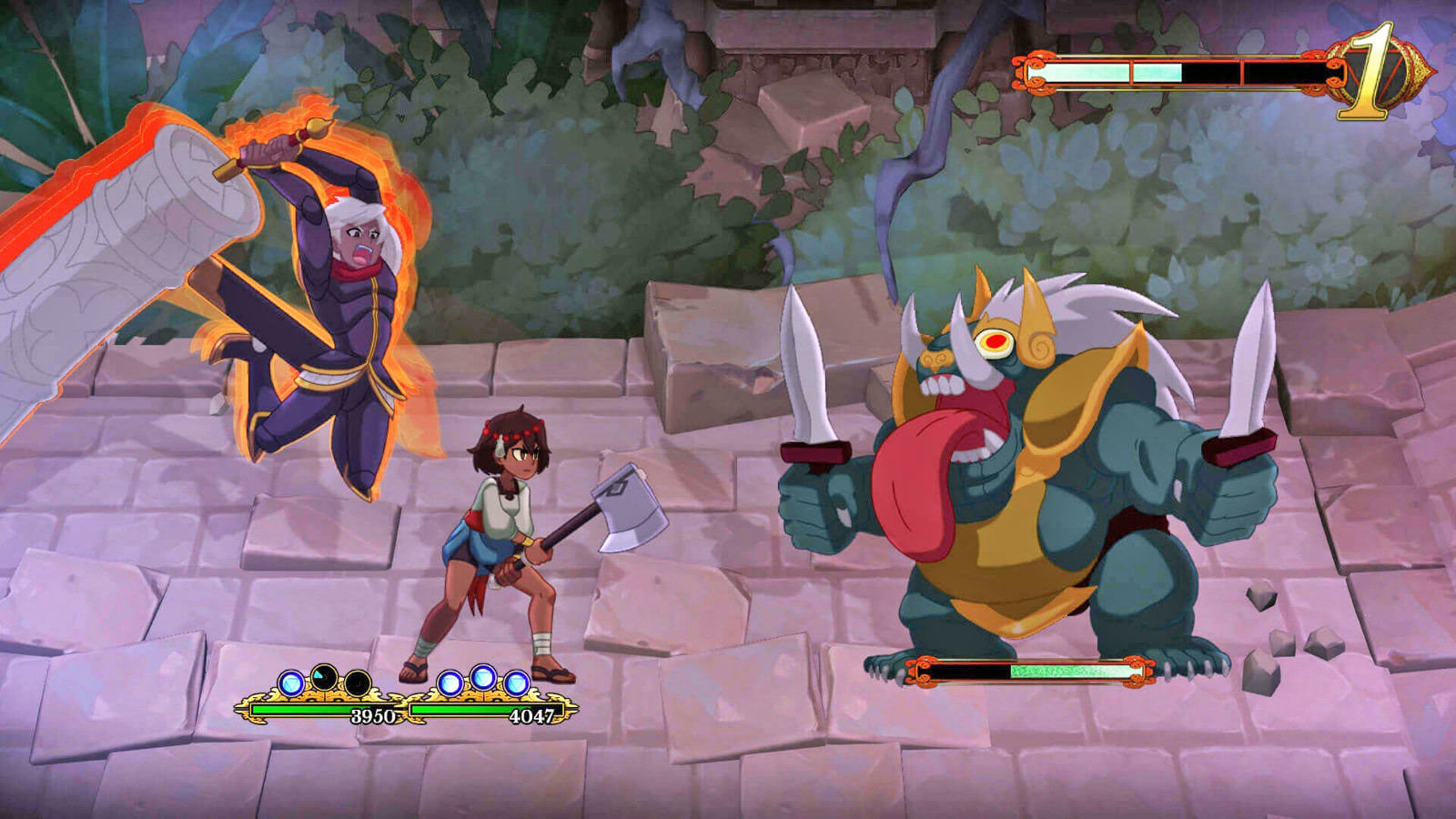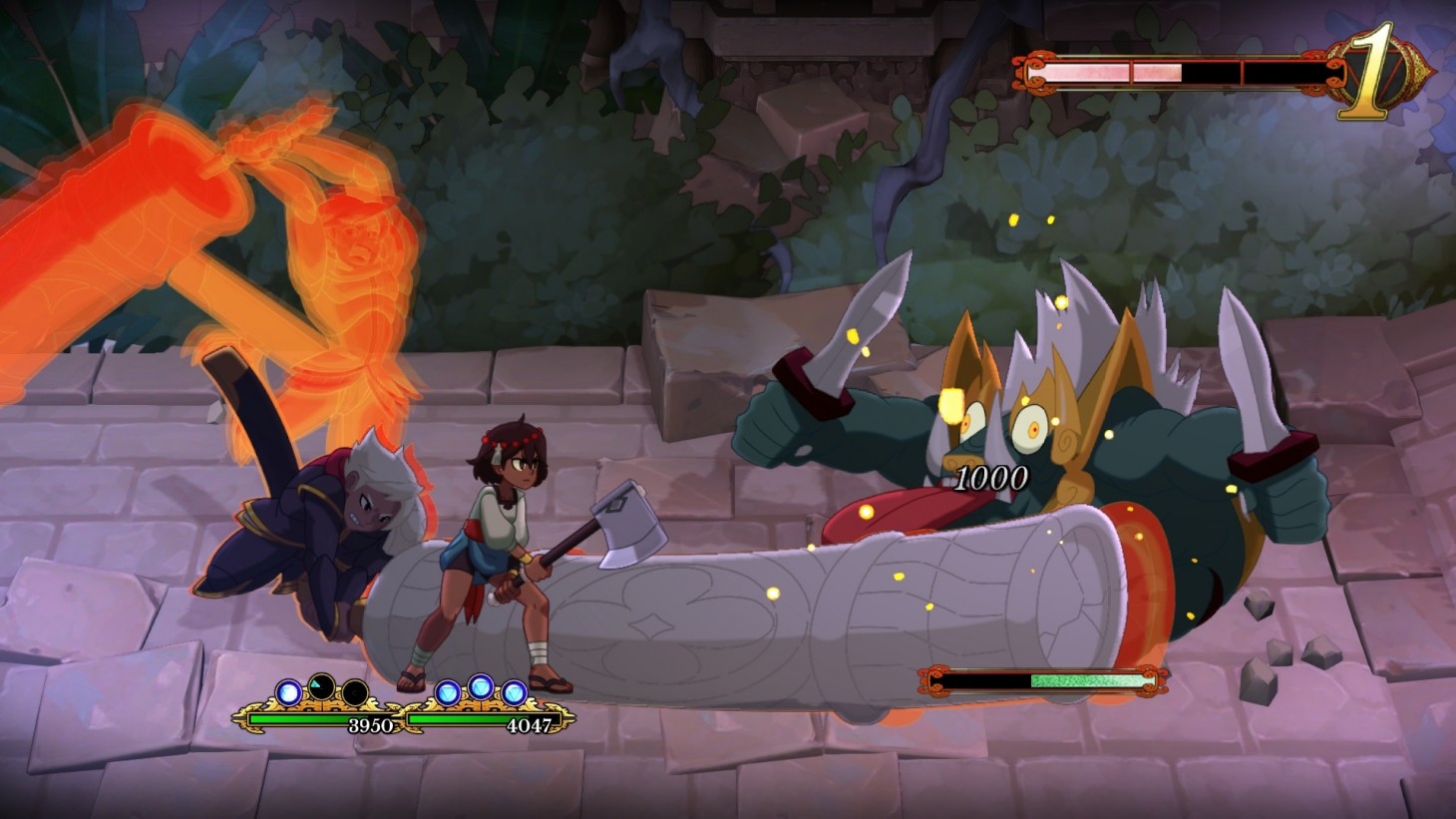The post Man’s Best Friends – The Very Best PlayStation Dogs appeared first on PlayStation LifeStyle.
]]>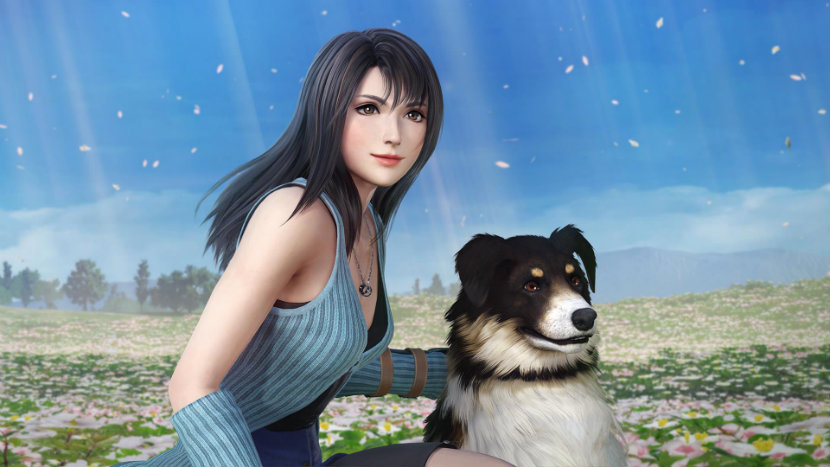
Editor’s Note: Today marks National Dog Day, so we’re republishing a feature on the very best PlayStation dogs. Original article, as published on May 2, 2019, is below.
Unless you’re a monster (or allergic or something), chances are you’re pretty okay with dogs. Man’s best friend and all that. Now, we live in an era in which the world of video games is really beginning to understand the appeal of a big ol’ floofer showing up to hang out with players. While today’s big question is whether or not the player can pet the dogs, we figured it would be fun to look back through the pages of PlayStation history at all the dogs with a bit more substance to their presence. From trusty sidekick to full-on starring roles, here are our (the Royal “our,” meaning me, my, and mine) favorite canine characters on PlayStation platforms.
Sant’ Angelo di Roma (Final Fantasy VIII)

Final Fantasy VIII has come to be one of the more controversial entries in the series lately, due in part to the apparent disappearance of its master source code. While we may never see a re-release on the level of its PlayStation peers, you can still get the PSOne Classics version. Anyway, Angelo belongs to Rinoa, the game’s leading lady. With the exception of a few plot moments, Angelo can be summoned as one of Rinoa’s Limit Break options, and reading pet magazines can expand her list of abilities. The most famous one, of course, is Angelo Cannon, which sees Rinoa fire the brave pupper off her arm like some fuzzy ordinance.
PaRappa the Rapper (Uh, PaRappa the Rapper)
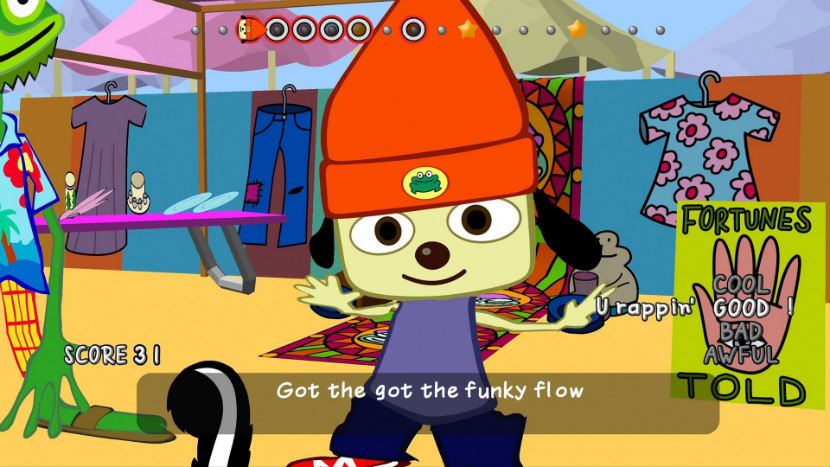
While there are only so many PlayStation exclusive dog characters, my boy PaRappa is a tremendous one. One of the defining games of the early PlayStation identity, PaRappa the Rapper combined music rhythm mechanics with the strange, but wholesome vibe emanating from artist Rodney Alan Greenblat’s cartoon style. PaRappa is generally a Good Boy, learning life lessons through the power of hip hop such as saving money, exercise, cooking, and patiently waiting in line for the bathroom.
Jake (Dog’s Life)
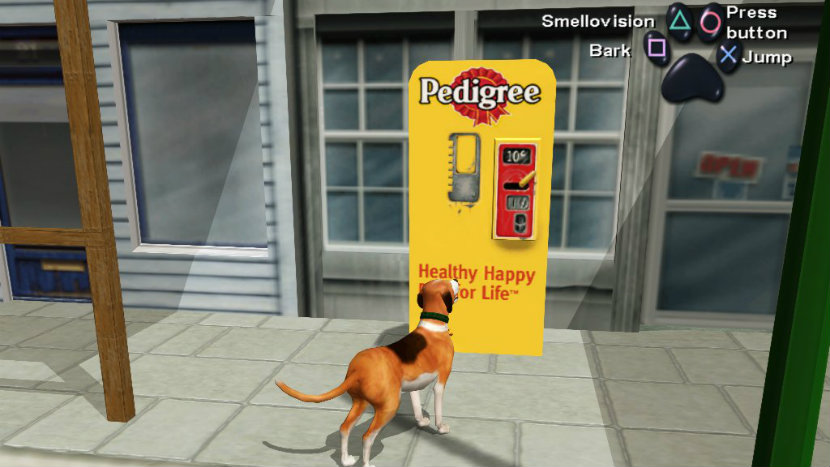
From Frontier Developments, best known today for Elite: Dangerous and Jurassic World Evolution, Dog’s Life was a surprisingly cute PlayStation 2 game all about the inherent strangeness of being a dog. Jake, the protagonist, is on a journey to rescue a lady dog from the local dogcatchers (video games gonna video game) and along the way he barks, smells things, and farts a lot. It truly is a dog’s life.
Amaterasu (Okami)
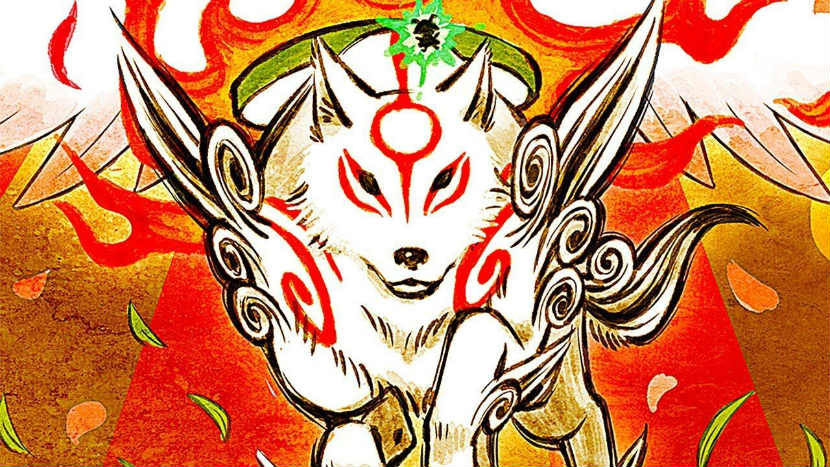
A long time ago, a studio called Clover existed under Capcom. This studio produced a number of incredible games that were underappreciated at their time, leading to Clover being shut down and the eventual creation of Platinum Games in its wake. One game that has survived beyond Clover is Okami, a Zelda-like game starring the sun goddess Amaterasu. Taking the form of a wolf, she uses paint-based powers to solve puzzles, defeat bosses, so on and so forth. She’s also one of the best characters in Marvel vs Capcom 3, which is a totally objective statement and not just based on my regular team.
Dogmeat (Fallout series)
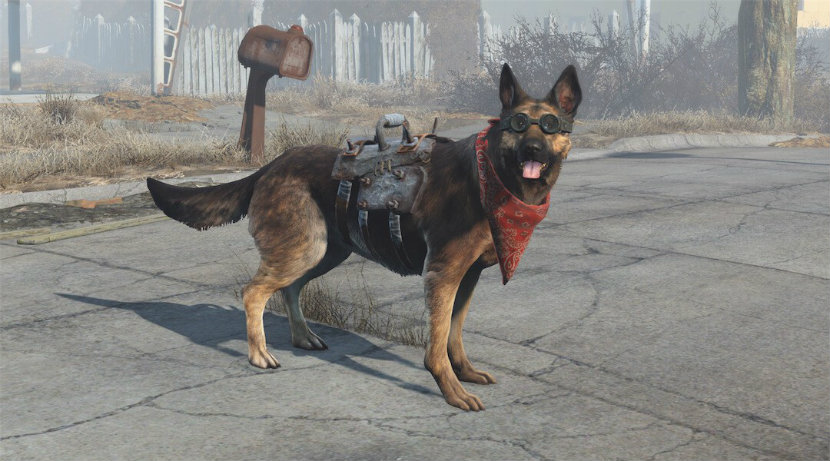
Dogmeat doesn’t exactly originate on PlayStation or hang out exclusively on PlayStation, but he’s great so he gets to be on the list anyway. Part of Fallout‘s whole deal is incorporating other post-apocalyptic media such as Mad Max and A Boy and His Dog, both of which feature awesome supporting dog characters. Dogmeat is a sort of tribute to those works, and totally helps the player out in various ways across games. In Fallout 4, you can even dress him up with unique equipment.
Koromaru (Persona 3)

The Persona series involves a ton of character drama, especially when the series took its current form starting with Persona 3. These games explore internal conflict manifested as demons from literal Christian Hell (and other religions, because why not throw ’em all together), and exploring the “social links” between people is a huge part of progression. So naturally, Persona 3‘s playable cast includes a dog who just barks and stuff. Koromaru is great though, and plays into the game’s mechanics in fun and creative ways.
Annoying Dog (Undertale)
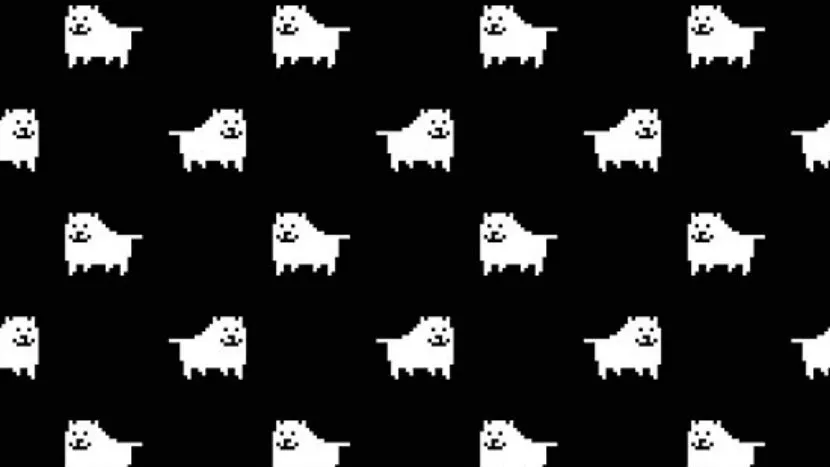
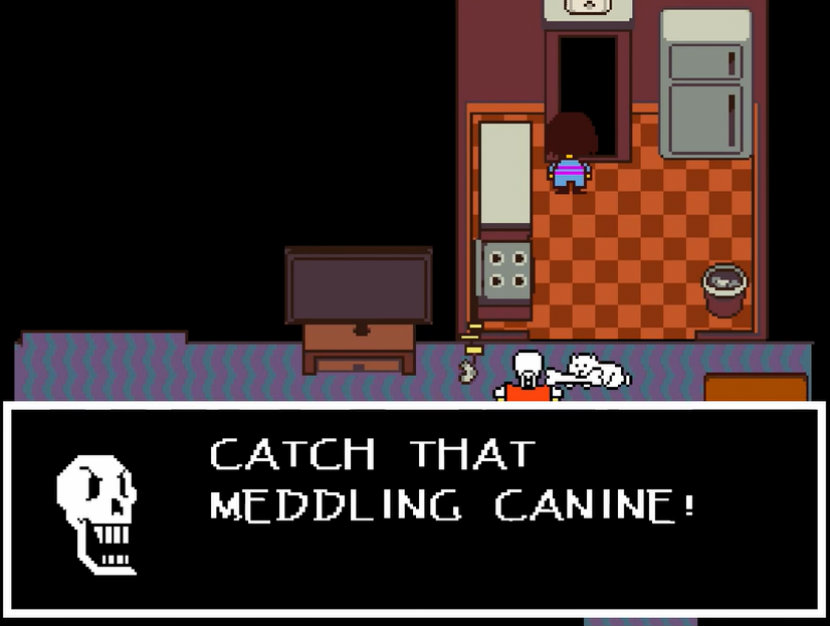
This page contains affiliate links to products. We may receive a commission for purchases made through these links.
The post Man’s Best Friends – The Very Best PlayStation Dogs appeared first on PlayStation LifeStyle.
]]>The post Will There Be a New PSP or PS Vita in 2023? appeared first on PlayStation LifeStyle.
]]>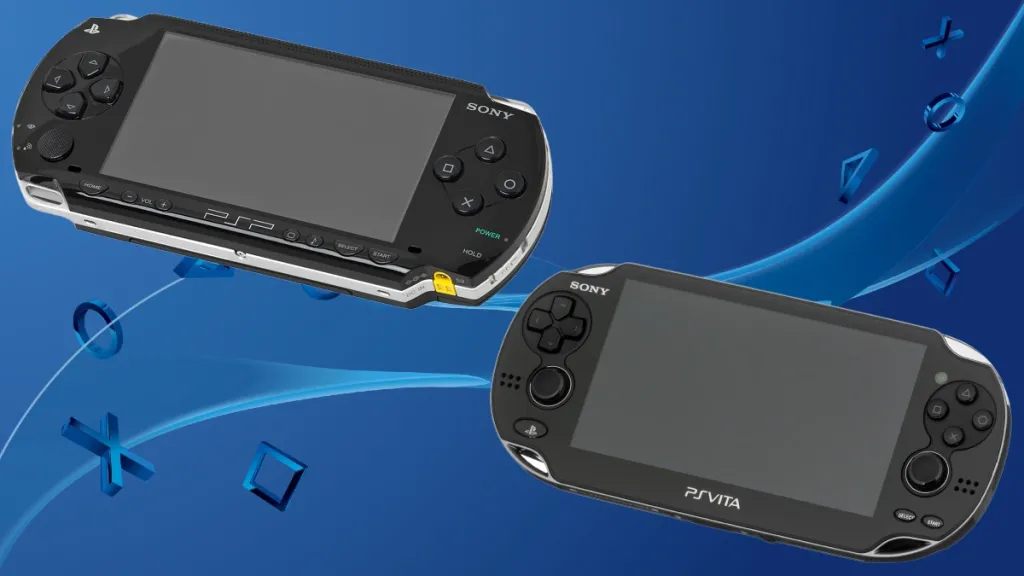
Ever since the Steam Deck launched, a new kind of fervor has spread across the gaming community. Handheld gaming, once considered a separate experience from console gaming, has penetrated the AAA space.
With Steam Deck competitors popping up left and right, and plenty of buzz on what’s after the Nintendo Switch, it’s only natural PSP and Vita fans showed up. Folks are out there wondering if it’s possible we could see a new PSP or PS Vita in 2023.
Obviously there’s nothing concrete or official, but there’s enough scuttlebutt to substantiate an article like this. While it’s unlikely we’ll see something as direct as a new PSP or PS Vita, that doesn’t mean Sony isn’t eying the handheld market. Especially since even Microsoft has dipped its toes in, not offering a literal Xbox handheld but working directly with companies like Logitech to endorse certain devices.
PS5 Remote Play Handheld Rumors
Multiple reports have risen to the surface, which suggest Sony is looking to jump into a niche within a niche with a device centered around Remote Play. We’ve already seen a PlayStation-branded Backbone, a mobile controller with software gimmicks for the official Remote Play app. But the likes of Giant Bomb’s Jeff Grub and Insider Gaming’s Tom Henderson have claimed Sony has a bespoke handheld device in the works.
Grubb hasn’t gone on the record with full-on reporting (simply tweeting he’s heard word of a cloud gaming platform). Henderson’s report comprises a device allegedly code-named “Q Lite.” If it’s real, this device has an eight-inch screen and is exclusively tied to Remote Play. That means a PS5 requirement and ostensibly super locked-down software. None of this is confirmed in any official capacity, so take it with a reasonable grain of salt.
So no, we shouldn’t expect a new PSP or PS Vita sometime in the next six months. But between now and 2024, it’s possible we could see this “Q Lite” project eventually surface in some capacity. Again, it’s all rumors and reports until Sony states otherwise. But hey, it’s fun to speculate, no?
The post Will There Be a New PSP or PS Vita in 2023? appeared first on PlayStation LifeStyle.
]]>The post Heroland Review – These Folks Need a Union (PS4) appeared first on PlayStation LifeStyle.
]]>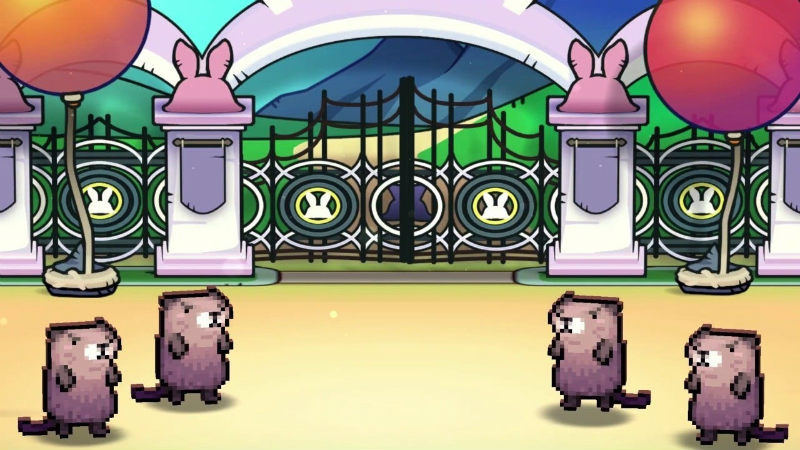
Heroland is a curious little game. Published by XSEED Games and developed by FuRyu, Heroland is packed with veterans from the Japanese video game industry. Those credits include director Takahiro Yamane (Fantasy Life), writer Nobuyuki Inoue (Mother 3), and composer Tsukasa Masuko (Shin Megami Tensei). That’s quite an eclectic blend of resumes, and the result may not be what you’d expect. Heroland is a small-scale RPG with more in common with mobile games than anything mentioned above. But it has a big heart, bursting with quirky humor and strange ideas for both play and story-dressing. Both fun and harrowing (especially if you’ve ever worked in service), Heroland is one of the stranger RPGs on offer this year but if it clicks, there is a lot of substance to dig into.
Working Stiff
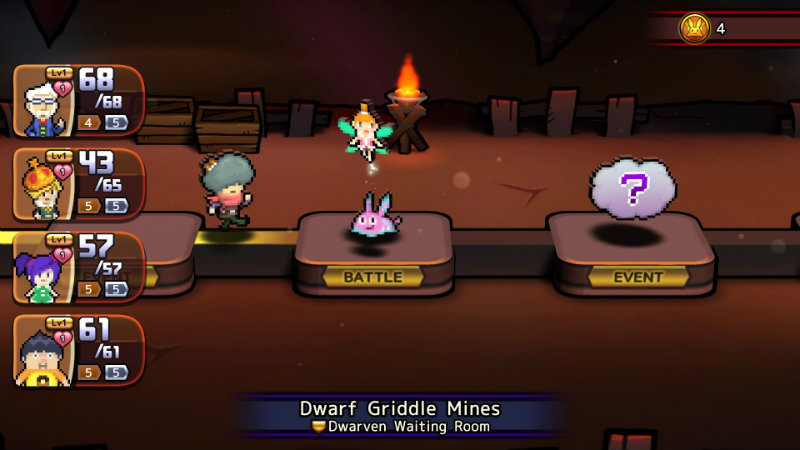
The titular Heroland is a Jurassic Park-like fabrication of RPG romance, located on its own island out in who knows where. A vast array of strange characters and creatures serve a mysterious CEO as part-time employees whose job is to make guests feel like heroes. These workers act as dungeon tour guides, allies in combat, and of course enemies and bosses. Customers pay to go on their own lifelike dungeon-crawling adventures, complete with loot should they manage to save the day. Once the sun goes down, Heroland closes its gates and the giant slugs, anthropomorphic otters, and dudes in bear costumes go “home.” Home isn’t really home since everyone lives on the island with nothing to do but earn minimum wage getting clobbered by tourists.
In Heroland, the player isn’t a guest. You play as Lucky, a downtrodden afro-sporting silent protagonist who finds himself washed up on shore and desperate for work. Lucky is hired as a tour guide, tasked with guiding adventurers through dungeons, providing them with equipment, and occasional guidance in combat. Lucky also gets to distribute loot as he sees fit, including keeping it himself for his quaint digs. But if the guests aren’t happy, they won’t dole out as much appreciation, and the payout (of currency only usable on Heroland, natch) suffers. So it’s a balancing act, between keeping customers happy and padding out your collection of stuff. There are benefits, as collecting certain items can open up equipment opportunities.
And equipment is crucial, since Heroland is half silly dialogue and half RPG combat. However, Heroland takes big-time inspiration from mobile games, robbing direct control from the player. Instead, the party acts mostly on their own with the tools they have. Lucky, surprisingly capable, has a meter that lets him give a single order once it’s full. Will he give one party member a specific command, use an item, or suggest a party-wide tactics shift? It’s all up to you and the strength of your tour guideiness.
Afrotactician
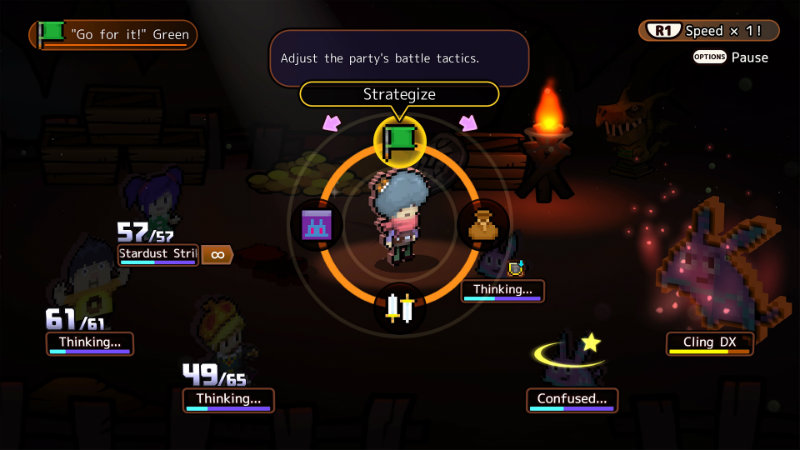
If mostly watching all the action sounds like a drag, Heroland won’t be for you. While leveling up gives Lucky more opportunities to act, the early game is much slower. Heroland is more about managing the bigger picture of a dungeon run, staying out of the way while the guests have fun but stepping in to make sure nobody dies. You do get to interrupt the action on demand once your meter is full, so a lot of the early moments are about assigning tactics in response to specific situations, or dunking a clutch health potion over someone’s head so they don’t leave the theme park in a body bag. There are plenty of cute distractions from the inactivity, with fun, flashy animations, random dialogue triggers between characters that lead to special moves, and crucial moments that practically require the player to issue specific orders at the right time. There’s also a fast-forward button, which makes grinding a cinch.
Most of Heroland’s appeal lies in how laid back it all is. With a few exceptions, you can pick at least one character for your party from your growing pool of adventurers, and kit them out however you like. They have preferred classes, but weapons dictate their skillsets. Weapons can break though, and the more SP you waste the more you risk losing your favorite. Heroland never gets mean or out of hand though, so weapon durability feels like more of an addition to the overall bit than a mechanic worth genuine worry. It’s a very low-pressure experience, perfect for spoiled tourists who thrive on inserting themselves in situations they shouldn’t be in.
We Got Jokes
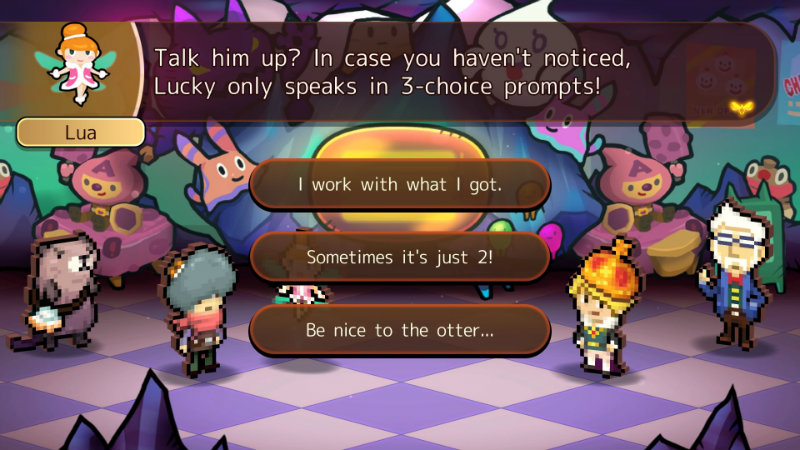
Heroland is funny, but it isn’t without a little bit of bite. Much of the early game, for example, is about a bunch of whiny members of a giant royal family bickering over their spot in the back of the line of succession. Naturally, it gets taken out on the workers, as the princes make unrealistic demands that often spiral out of control as the workers try to meet them. And as you find out more about the secrets behind Heroland’s management, let’s just say that there’s some decent commentary on things like labor conditions hidden between all the gags. You won’t get a deep takedown of capitalism or labor abuse here, but Heroland does have a bit of substance under the surface. That helps the comedy, which is a growing collection of running gags, stand out and land a bit better. The localization is great, and even when it’s trying too hard, it comes off as part of the joke.
Heroland is an excellent “podcast game.” You can take your time with the actual important parts, paying attention to new boss battles and enjoying the story, then zone out with a show or something while you grind older levels to get your party up to speed. You never feel rushed or burdened by Heroland, even though the actual situation is kind of terrifying by real-world standards. It isn’t the most active or deep RPG to come from Japan, but it is well-made, deliberately designed, and full of cute and funny writing. It’s the kind of experience that could have easily been a free-to-play mobile game, but the extra shine, polish, and meat on its bones justify its spot in the PlayStation 4 library. It’s also perfect for Remote Play, even on devices (like Chromebooks) that don’t support DualShocks just yet.
Heroland review code provided by publisher. Version 1.00 reviewed on a Standard PS4. For more information on scoring please see our Review Policy.
The post Heroland Review – These Folks Need a Union (PS4) appeared first on PlayStation LifeStyle.
]]>The post Interview: On Character Design With Katsumi Enami, Artist for Star Ocean: First Departure R appeared first on PlayStation LifeStyle.
]]>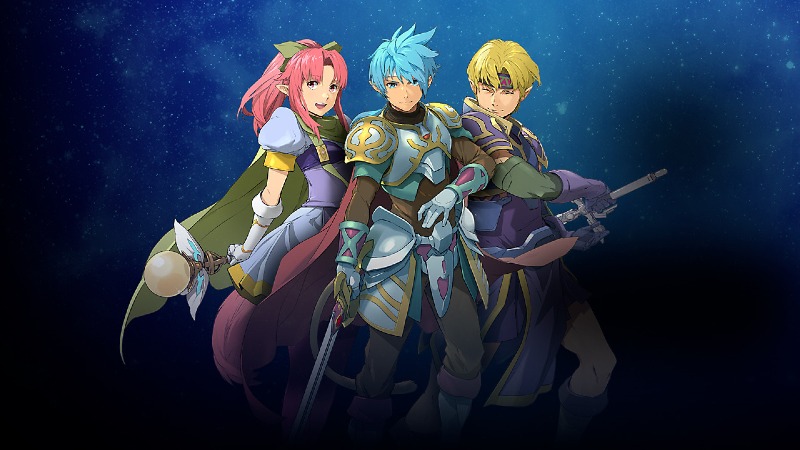
The original Star Ocean is back, once again! Star Ocean, (formerly) Enix’s sci-fi action RPG series, never made it to North America in its original 1996 Super Famicom form. But roughly ten years later, the first game would appear on the PSP as Star Ocean: First Departure. This year, Square Enix is bringing that version to modern platforms as Star Ocean First Departure R. While this port is largely based on the PSP version, which had new art from Production I.G., Square Enix brought on freelance artist Katsumi Enami to provide new character design work.
Enami, who has made his name doing art for series like Baccano! eventually landed a gig with Square Enix for Star Ocean: The Last Hope. As part of the series’ DNA, Enami also contributed illustrations for mobile game Star Ocean Anamnesis. A fan of the series himself, Enami has found himself in the position of not only putting hands on the original game but also on character designs he didn’t create.
We got the chance to shoot Enami some questions, and as the resident PlayStation Lifestyle JRPG Nerdface, I was glad to take on the opportunity. As always I’m curious about the process, but I also wanted to get a video game artist’s perspective on ownership. Any IP-based project like this can seem like mercenary work in some ways, and as a writer, I often wonder if artists struggle with validation when illustrating for properties they don’t have true control over. Enami’s answer was fascinating and helped me develop a more rounded perspective on this workspace.
Also, the other questions are pretty good too. Please read them!
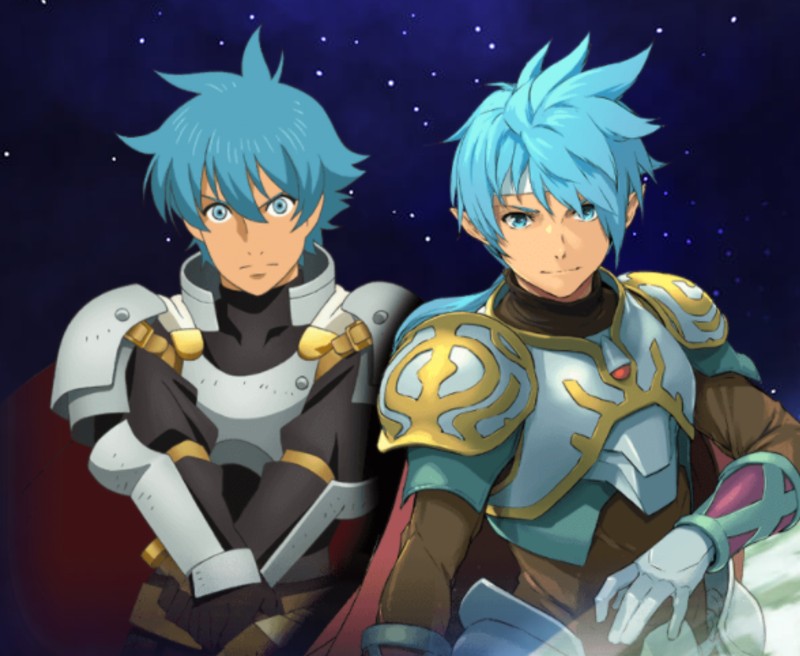
PSLS: Were you familiar with Star Ocean before you were professionally involved with it? If so, what does the series mean to you?
Katsumi Enami: At the time of Star Ocean’s original release, I spent my days delving into games, so I had played the title as well. Thereafter, I left the video game company I had been working for to become an illustrator, and never in my wildest dreams did I think that I would be involved in the series with my work on Star Ocean: The Last Hope. This title also served as an impetus for many people coming to know me as a character designer on games, so personally, it’s also an important title that I hold close to my heart.
PSLS: What would you say stands out the most about Star Ocean when it comes to how the characters are created or designed?
Enami: It depends on the content of the game, but perhaps I’d say the fact that fantasy and sci-fi elements are always intermixed across the series, but that each individual game has its own unique designs that suit that particular title.
PSLS: How does doing design work for video games differ from other mediums, if at all?
Enami: Nowadays, unlike the past, games are not so different from videos, so I don’t think there’s much of a difference in the design work required for both mediums. That said, in games, sometimes we need to emphasize (perhaps even over-emphasize) the character’s unique qualities in consideration of the game’s specifications.
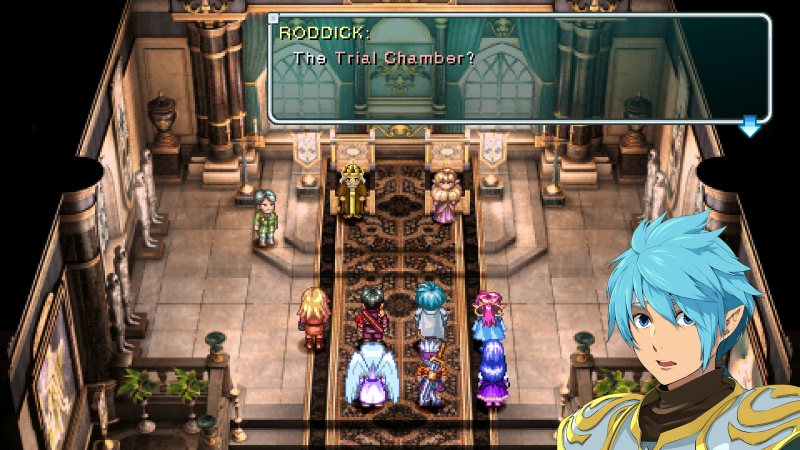
PSLS: When creating art for characters that aren’t your intellectual property, how would you describe your sense of ownership for that work, if any?
Enami: For illustrators, I think the majority of work entails just that, but even so, seeing a character you have personally designed move and speak is one of the joys of this work, and also builds quite a sense of attachment. If a project I am involved with becomes famous, I consider it to also be an evaluation of myself, and for someone who makes a living out of this profession, opening new opportunities for yourself is one objective, so there’s quite a sense of ownership there.
PSLS: Are there any unique challenges associated with illustrating characters for an update of a previous work, as is the case with Star Ocean: First Departure R?
Enami: There are quite a few challenges and pressure associated with finding a blend that would be considered acceptable to fans to maintain the image a title has built over the years while also incorporating my own style, which was the reason I was asked to come on board as the illustrator in the first place.
PSLS: Do you have any practices or routines when doing illustration work that help you focus and achieve your desired quality?
Enami: Nothing in particular, but I always have a movie or anime that I like from a visual standpoint continuously playing in the background while I work. My focus doesn’t last very long, so a quick glance at an anime or video I enjoy helps revive my motivation.
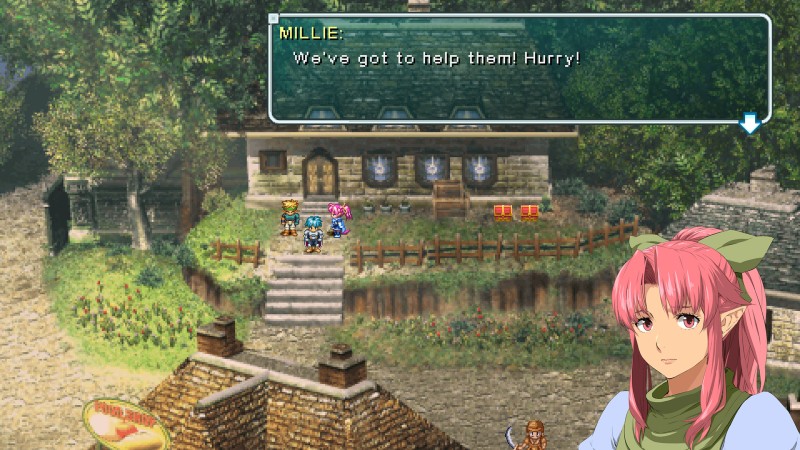
PSLS: Do you have any advice for aspiring artists?
Enami: If you intend on making this a profession, I think it’s important to have the desire to draw something that brings joy to others, in addition to knowing what you want to draw.
I feel like if you can enjoy artwork in the same way that consumers viewing it do and can also understand why that artwork is desired/in demand and enjoy drawing that subject matter yourself, then you could make this a lasting profession for yourself.
PSLS: What’s your favorite part of working on video games, and is that different compared to working on other mediums?
Enami: It’s close to anime, but I think it comes down to how enjoyable it is to see the characters you design move and speak. Moreover, you can control the characters in video games, so from an illustrator’s standpoint, perhaps it may even be more enjoyable than anime.
Katsumi Enami is an illustrator who hails from Hiroshima prefecture. He worked as a graphic artist after joining Compile Co., Ltd., while posting and sharing his illustrations online. His artwork caught people’s attention, which led him to work on providing illustrations for the Baccano! novels. From there, he would go on to illustrate and create character designs for other light novels and video games. For the Star Ocean series, Enami created all the character illustrations for Star Ocean: The Last Hope and Star Ocean First Departure R. He also contributed multiple character illustrations to the smartphone title Star Ocean Anamnesis. (Bio provided by Square Enix PR)
Thank you to Katsumi Enami for taking the time to answer our questions!
Star Ocean: First Departure R comes to PlayStation 4 on December 5, 2019.
The post Interview: On Character Design With Katsumi Enami, Artist for Star Ocean: First Departure R appeared first on PlayStation LifeStyle.
]]>The post The Legend of Heroes: Trails of Cold Steel III Review – School’s Back in Session appeared first on PlayStation LifeStyle.
]]>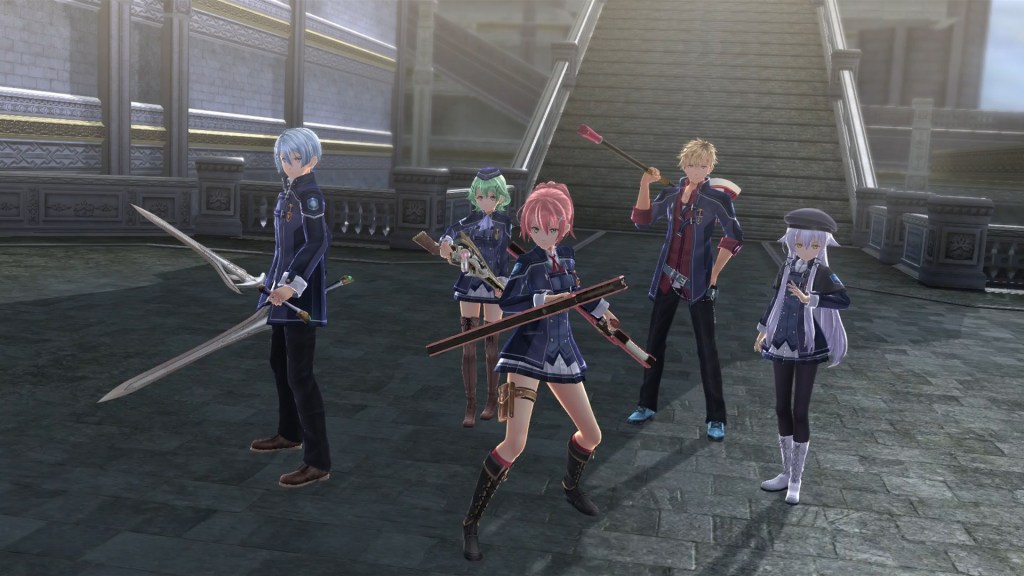
I could practically trace my whole writing career via Falcom’s The Legend of Heroes series. As a whole, it’s been around since before I was born, but I was right there hustling as a budding games critic when Trails in the Sky dropped for the PSP. It wasn’t the first to be localized, but it was the first to really find an audience. Nearly a decade later, this world’s story is still being told. Spanning across multiple continents and real world gaming platforms, we’ve finally landed on the first native PS4 entry. Trails of Cold Steel III is the latest in one of the biggest epics in JRPG history in scale alone, and arguably the biggest in heart. The journey isn’t over yet, but the ride is only getting better with time.
The student has become the teacher. And a mech pilot. And a war hero. Also he’s taller.
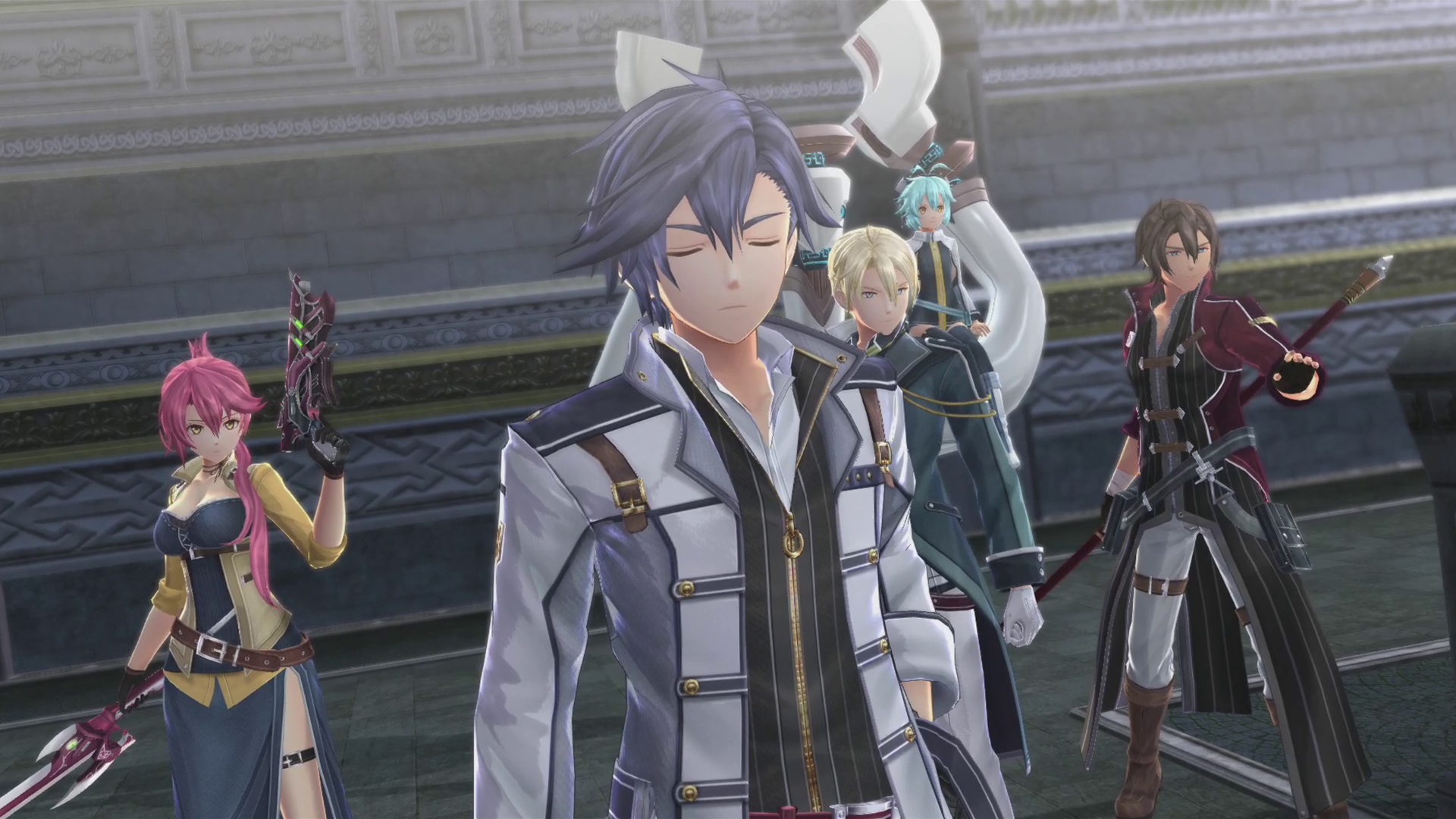
While the previous Trails series took place in the rural Liberl and the stubbornly independent Crossbell, Cold Steel takes us inside the Erebonian Empire. After several games setting the nation up as the bad guys (and I mean, it’s an empire), it seemed odd to travel there as a player. But the team at Falcom used this shaky setting as a platform to examine ideas such as skepticism, loyalty, and class.
Instead of soldiers, cops, or mercs (Bracers here), Cold Steel took us to a classroom. Instead of drinking the Erebonian Kool-Aid, through the eyes of Class VII we got a scenario assuming the challenges in living in an antagonistic military force of a country. We saw struggles in and outside of each classmate, and that was before the grassroots coup that changed the face of this world forever.
The first two Cold Steel games told a complete story, but the world doesn’t stop spinning just because the bad guys lost. The world moves on, motivations change, borders change, people change. Set a year after graduation, we still take on the role of Rean Schwarzer. Now seen as a war hero (despite the truth being more complicated), Rean has decided to become a teacher at a Thors Military Academy sister school. Naturally, Rean is given charge of a new Class VII, and sets out with a new group of students living in a new Erebonia. If you’re familiar with the events of the first two games, particularly how wild things got, well, you ain’t seen nothing yet.
It wouldn’t be appropriate to go into much further plot detail here, but rest assured Cold Steel III lives up to the scale and nuance of the rest of the series. These games are practically novels, their script lengths notorious and even responsible for some past industry drama. XSEED is no longer publishing and localizing Falcom titles in the west it seems, with NIS America now steering that ship. The localization here is just as good as before, and I suspect part of that is likely due to some shared credits. The localization’s voice is so similar, so full of the same life and heart, that it would be hard to believe otherwise. Sure, some of that is the source material, but like Erebonia, it’s always more complicated.
When’s there’s nothing left to fix, add more stuff?
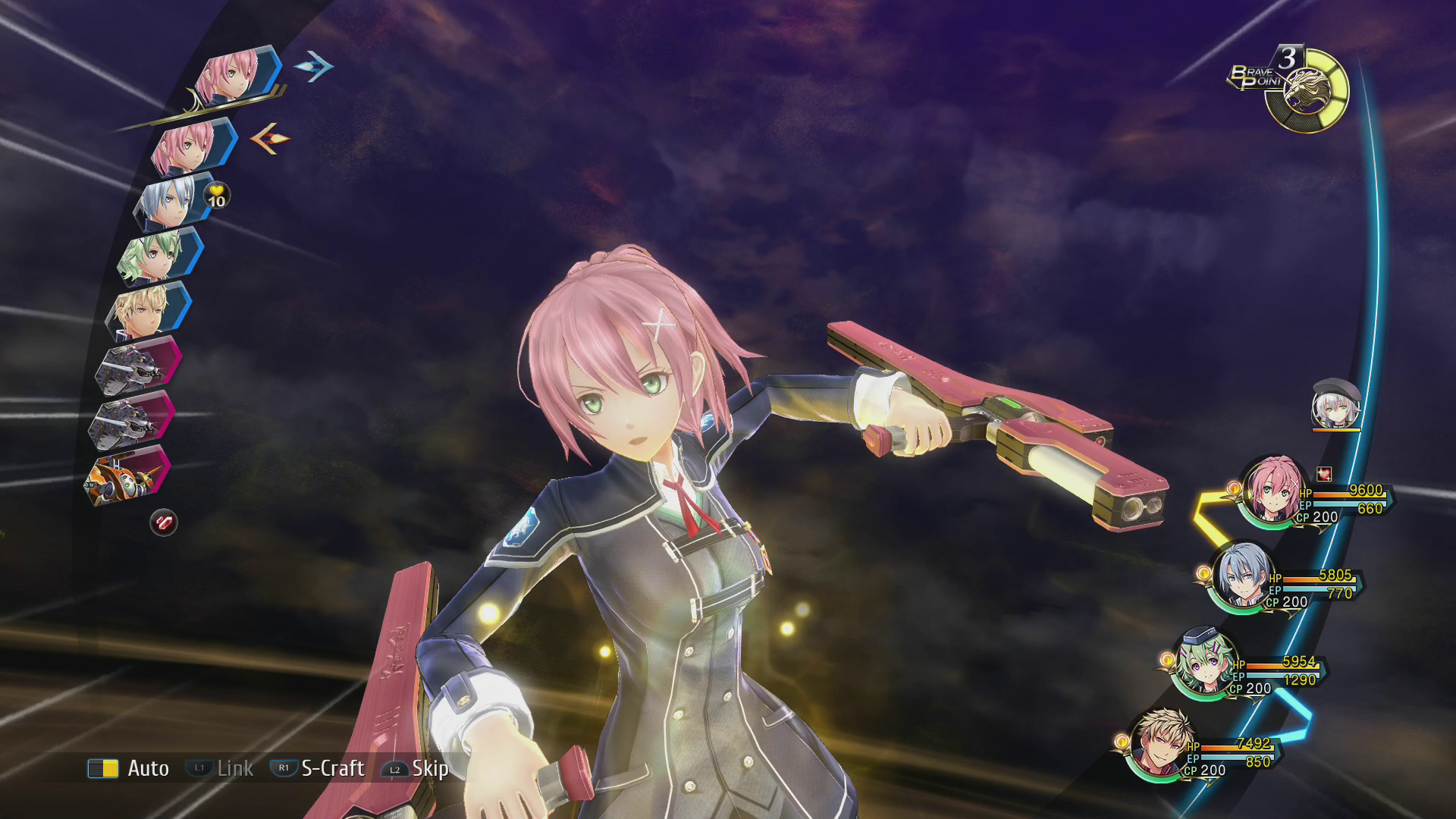
As far as actually playing Cold Steel III instead of just bathing in its dense storytelling, not a whole lot has changed here. The typical Legend of Heroes formula hasn’t changed much, mostly iterating on itself and making quality of life adjustments here and there. It’s mostly typical turn-based JRPG fare, with a Materia-like system governing stats and abilities. Cold Steel introduced mechanics revolving around “linking” characters together, along with, well, giant robot battles. Battles are almost identical in part three, although mecha combat has been expanded (and streamlined), and a few extra options in a normal fight have been added. Falcom has been working on things like follow-up and combo attacks, so more opportunities for that have been added.
What’s more drastic is Cold Steel III’s visual fidelity. It’s still a Falcom game, meaning it’s more interested in narrative and systems than being impressive to look at. However, since we’re no longer dealing with the PS3 or (more importantly) the Vita, there’s an immediately noticeable step up. The colors are brighter and stronger, the character models have more detail and stronger features, and the performance is much smoother. Overall Cold Steel III, while not exactly an AAA game, definitely shows off its new home on current-gen hardware.
We’re in it for the long run – are you?
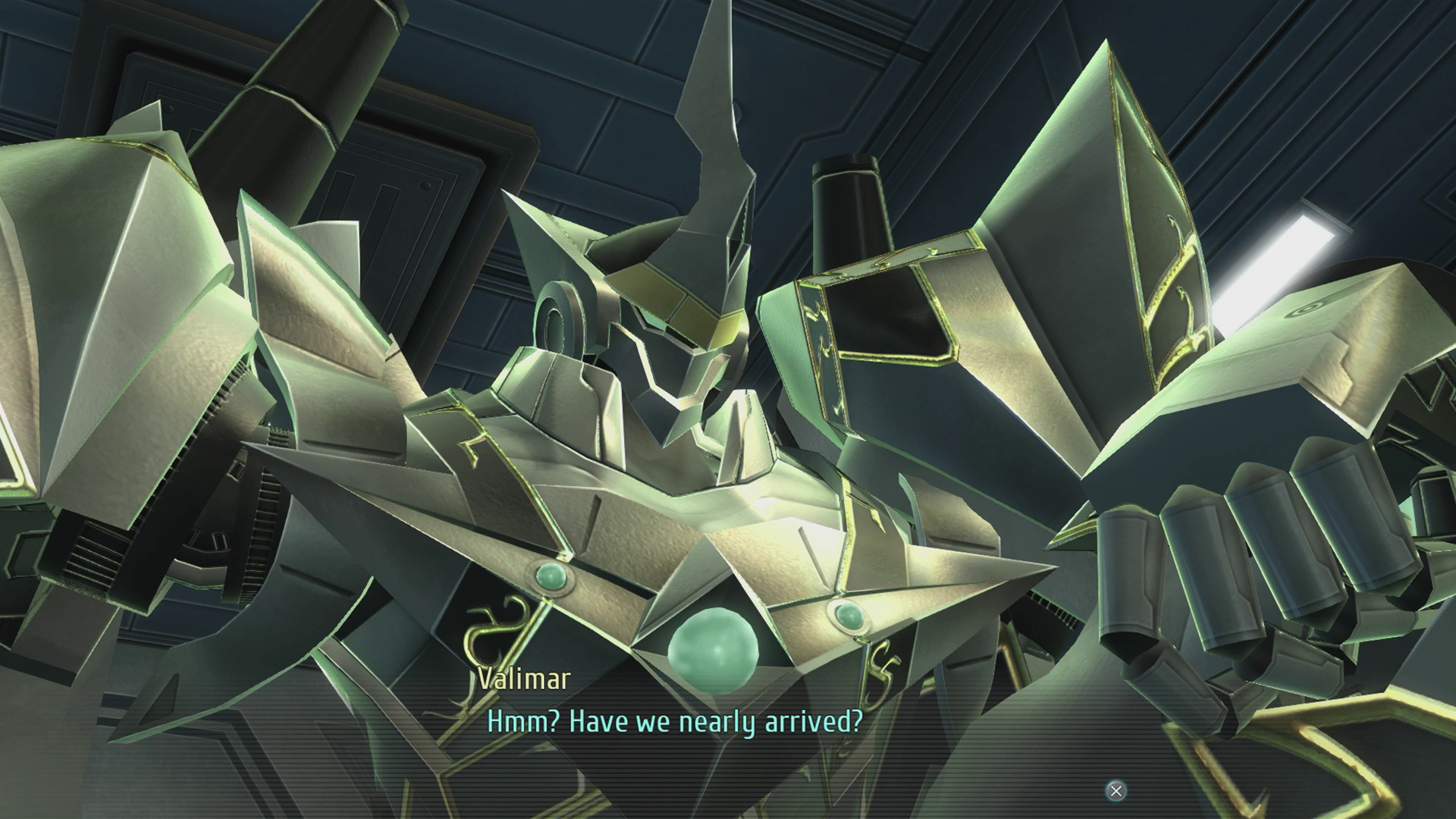
It’s easy to say a sequel like Cold Steel III is “more of that thing before,” but as true as it is, that betrays just how much more that is here. These games are enormous, and the developers and writers consistently delivering on the scale they do is impressive every time. While the mechanical and technical changes are small and iterative, there’s really no need for anything more. This is another massive story to dig into, that’s just as fruitful and compelling as the stories before it. As the third game in a set of direct sequels, tied into several other games set in the same world and timeline, it’s simply amazing those creative juices are still flowing and coherent. It’ll be over soon, but jeez, hell of a run.
The Legend of Heroes: Trails of Cold Steel III review code provided by publisher. Version 1.00 reviewed on a Standard PS4. For more information on scoring please see our Review Policy.
The post The Legend of Heroes: Trails of Cold Steel III Review – School’s Back in Session appeared first on PlayStation LifeStyle.
]]>The post Destiny Connect: Tick-Tock Travelers Review – An Adorable Adventure From the Demon Dev appeared first on PlayStation LifeStyle.
]]>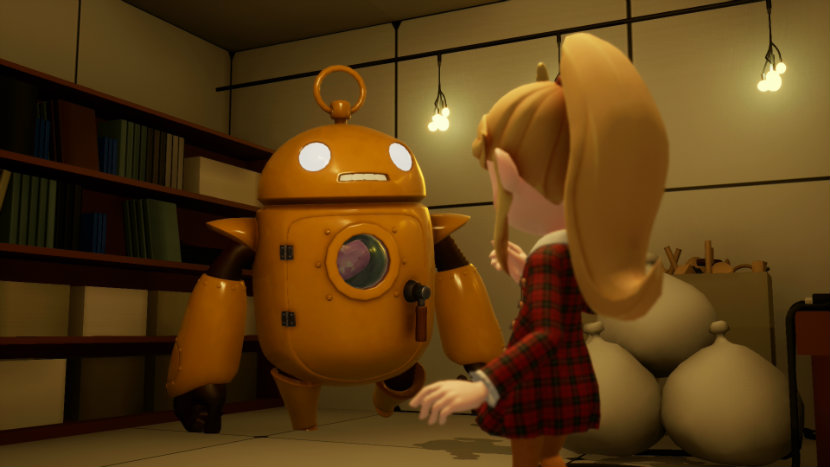
Usually when a Nippon Ichi Software joint rolls along I expect something a little edgy. That’s especially true these days as NIS proper has mostly retreated to its core IP (Disgaea) and only occasionally does new things (not to discredit NIS America, which has impressively expanded its publishing operations. Even when it does, NIS still sort of hovers around “quirky JRPG about demons.” So when Destiny Connect: Tick-Tock Travelers was announced, it immediately caught my attention with its more cartoon-like style. I didn’t look into it further, but when it landed on my digital doorstep, Destiny Connect surprised me with its earnest attitude and vomit-inducing cuteness. While it may not succeed at its apparent teaching goals, Destiny Connect does succeed in standing out by leveraging old school tradition to do something a little different by modern standards.
Hickory Dickory Clock(nee)
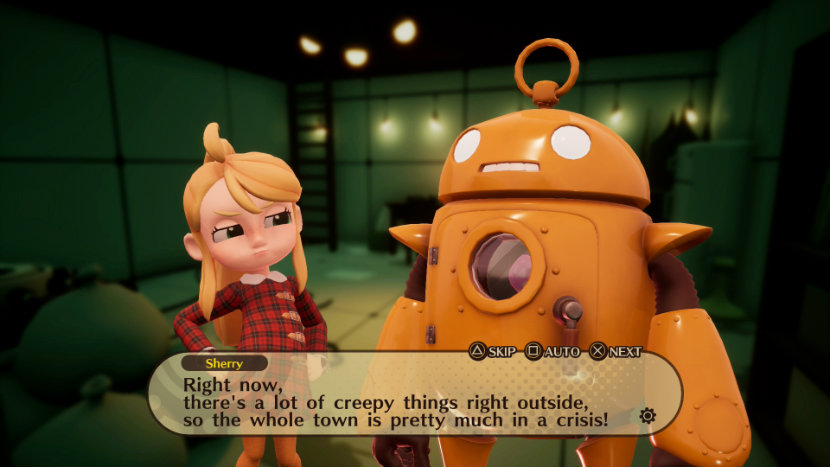
Clocknee is a small town inhabited by small people, including the innocuous but spunky Sherry. She lives a quaint life with her mom, and is lucky enough to have her café-owning grandmother practically across the street. Sherry’s biggest problem is her father; he’s hardly ever home, and when he is he isn’t exactly reliable. Destiny Connect opens on the day of a festival, and Sherry looking forward to her dad’s planned return. Of course, he ends up being unable to come at the last minute and Sherry is disappointed once again. Then, just as the festival starts, the entire town freezes in place. If that isn’t weird enough, all the technology in town violently comes alive and Sherry is only able to defend herself via Isaac, a friendly robot who appears out of nowhere. Isaac can time travel, and is mysteriously connected to her dad. From there, things get weird(er).
Like Mystic Quest, but Good?
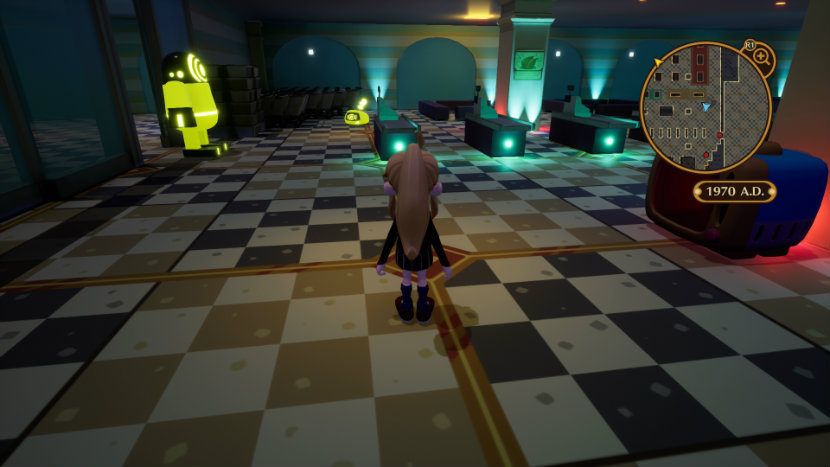
Instead of the usual sardonic, macabre humor of typical NIS works, Destiny Connect wears its heart on its sleeve. It’s a whimsical, fairy tale-like story that wants smiles and tears instead of laughs. It’s also a simple, breezy story – it has a remarkably low runtime for a 2019 JRPG at around 15-20 hours—full of cozily archetypal characters, easy combat, and tons of tutorials. This lackadaisical tone that powers all of Destiny Connect is somehow a huge boon for the adult JRPG fan, despite how clearly it wants to be an entry point for actual children.
So, Destiny Connect is short, simple, easy, friendly, and full of tutorials. And by full of tutorials, I mean stuff that most JRPGs take for granted is explained as plainly as possible. It really stood out and kinda bothered me at first as a seasoned role-player, but once I realized what was happening I grew to appreciate it. I’m a father, and my kid is just as into games as I am. But some games are tough when you’re six or seven. He loves Pokemon, but sometimes it can be a bit much, especially when he has trouble focusing on things like grinding levels or navigating a dungeon/cave. Destiny Connect feels like a perfect teacher, a game designed to deliver concepts folks my age mostly had to figure out by osmosis.
That sounds great, but I’m not sure Destiny Connect exists in the right time or place to actually achieve its mission. At least over in my geographical neck of the woods, NIS games are firmly niche territory, therefore knowing about them kinda inherently requires a savvy audience. I could pass it over to my kid since I have it already, but I doubt he’d pick that off the shelf instead of something like a Pokemon or Yo-kai Watch. It’s kind of a scale thing. That said, as a grown-ass man with a family and multiple jobs, Destiny Connect hits a rare spot I wish could be hit more often. I just can’t play every 50-plus hour JRPG that comes my way, despite how badly I want to. But here, I can enjoy the lighthearted story, cute characters, easy grinding and fun visuals.
Tick-Tock Vibing
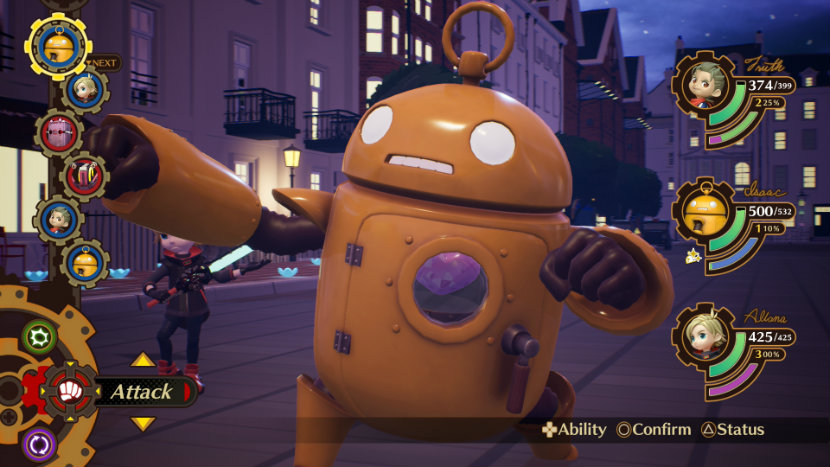
Sometimes when I’m playing a game, I don’t necessarily want to be challenged. But I’d still like to stay in my wheelhouse at the same time, you know? That’s tough for me, since my default stomping grounds involve experience points, menus, and skill points. And at this point in my life I’m kind of out of Dragon Quests. But just in my time of need, NIS has stepped out of its comfort zone and made Destiny Connect, a whimsical romp that doesn’t try too hard or overstay its welcome. It’s a light snack in a genre full of hearty feasts. It won’t blow your mind or change your life, but Destiny Connect will help you relax for a while.
Destiny Connect: Tick-Tock Travelers review code provided by publisher. Version 1.00 reviewed on a Standard PS4. For more information on scoring please see our Review Policy.
The post Destiny Connect: Tick-Tock Travelers Review – An Adorable Adventure From the Demon Dev appeared first on PlayStation LifeStyle.
]]>The post Indivisible Review – RPG Salsa appeared first on PlayStation LifeStyle.
]]>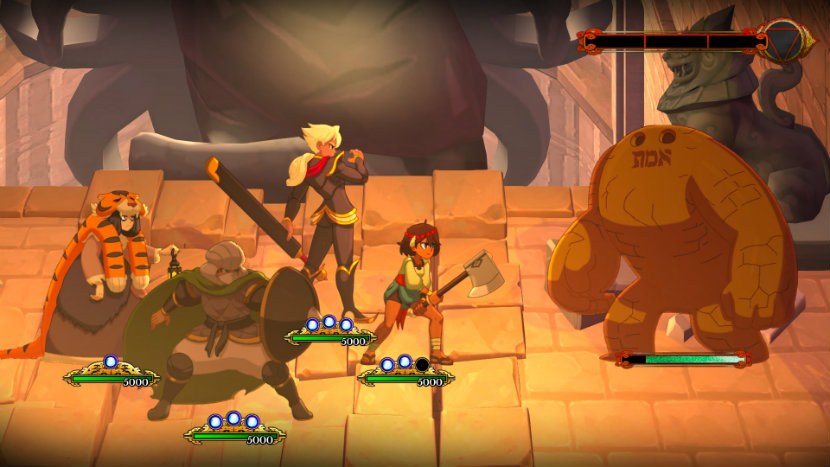
Salsa is weird. It’s a bunch of stuff thrown together in a jar, often with a bizarre consistency, always vibrant with primary colors and strong flavors. You’d never eat it by itself because of its chunky, goopy physicality and acidic or spicy taste, but it’s great when you use it as a topping; but not just any topping, a “dip.” You take something salty like a chip and scoop that crap up like you’re bucketing dirty water out of a ground well. Yet as weird as it all is conceptually, if there’s a plate of chips and a can of salsa in front of you, you’re compelled on a primal level to consume all of it. Somehow this is a metaphor for how I feel about Indivisible.
Running, Jumping, and Grinding
Indivisible is from Lab Zero Games, the minds behind Skullgirls. While that game was a lightning-fast tribute to Marvel vs Capcom with a few of its own tricks, Indivisible has more in common with the original Valkyrie Profile. If you’ve played that, or any older Monolith Soft titles, you’ll know exactly what to expect from Indivisible. It’s also curiously similar to Idea Factory’s recent Super Neptunia RPG. It’s a lot like that game, except less bad. Like a lot less bad.
While it’s definitely a RPG, Indivisible’s structure exists entirely on a 2D plane. There is as much platforming, if not more, than there is combat. When you’re running around between objectives, Indivisible almost looks like a metroidvania. But that’s mostly surface-level aesthetics based on running through tunnels and glancing at a blocky map to know where you are. It’s pretty linear, and while there are secret collectibles and different traversal options, you aren’t exactly backtracking and unlocking new spaces with new abilities.
There is a lot of wall-jumping, however, and a cool double jump-like maneuver that has you using an axe to cling to walls. The platforming isn’t rewarding in the same ways a Metroid or Donkey Kong are, but it’s fast, responsive, and generally unobtrusive. Plus, Lab Zero’s distinct style and expensive-looking animation makes every second of gameplay into eye candy. Unfortunately, like many games with giant, hand-drawn characters combined with platforming, it can be extra hard to judge things like collision during tense moments.
Granted, tense moments are usually just about the transition into Indivisible’s combat system. When you encounter an enemy and either hit it or it hits you, the game seamlessly starts combat, which itself plays out in real time. Just like in Valkyrie Profile and similar games, once a character’s respective gauge fills, you can attack with the corresponding face button. Characters can build up multiple actions, and based on your timing and attention span, you can rack up some combos by utilizing various juggle properties and other special effects.
It all looks great and functions exactly as it should, but oftentimes something feels like it’s missing. Combat is fast, but it almost feels too fast. It’s hard to maintain combos because of how quickly most moves play out, versus how quickly enemies touch back down to recover. It also doesn’t feel like Indivisible is always as responsive as it should be, especially when you’re using directional inputs to access key techniques. Attacks lack a sense of impact, which is really important for games like these.
Combo Theory
I’ll use a particularly obscure example to prove I’m not just an idiot. Before the Xenoblade days, Monolith Soft was experimenting with 2D RPG combat. The industry was in the middle of convincing itself nobody liked turn-based combat, and throwing darts at walls. Seemingly inspired by fighting games, Monolith Soft developed a system across several games that combined turn-based combat with directional inputs and juggle-based combos. This started with Namco X Capcom on the PS2, was refined in Super Robot Taisen Og Saga: Endless Frontier, and has arguably culminated in the Project X Zone series.
Monolith Soft’s idea diverged from the Valkyrie Profile thing, with each character getting their own turns and having those varying commands I mentioned earlier. But the main draw was combos – in Endless Frontier, Monolith Soft leaned on elaborate sprite animations, and more importantly meaty, juggly combo strings. Players could experiment with each move’s properties, and find their own ways to build big combos. Each strike had weight and impact, and had clear tells for how they affected enemies. With such clear visual language, players could easily find a path to mastery.
Indivisible doesn’t have that same visual language. Granted, combat here isn’t nearly as intricate as Monolith Soft’s hybrid action/RPGs. There are limited commands, and super moves, but each character is still locked to a face button Valkyrie Profile-style. So it’s sort of a mix, but the way you can break an enemy’s guard and find your own way to juggle them totally took me back to Namco X Capcom. It’s a lot more fast and loose though, and because there’s so little “oomph” to hits, it’s more difficult and less satisfying to make large combos. Also due to the single-button setup, it can sometimes be more effective to mash everything out.
Still Working on that Salsa Metaphor
That said, there’s a lot of variety in Indivisible’s character roster. Ajna, Indivisible’s protagonist, does this weird thing where she stores her party members inside her head. It’s like Pokemon but with humans, and also way more creepy. Ajna can venture into her inner self and chat with everyone, but otherwise they’re just… trapped in there? Not all of them are okay with it either, which seems like a pretty serious ethical issue considering how likable Ajna is supposed to be. That aside, the party gets all kinds of options, with healers, an archer, melee-focused fighters and an almost entirely dedicated healer. And each of these characters can contribute to the combo system distinctly. Some characters also have passive moves that provide buffs and whatnot, which can be incorporated during strings. There is a lot of neat stuff happening in Indivisible’s combat, and my “these combos aren’t as cool as they look” gripe is relatively minor overall.
Defense is also a major factor in combat. There’s a meter that fuels special moves, but holding the block button depletes it. So you’re encouraged to get the instant block timing down as much as you can, in order to conserve meter and get the big boy damage. This organically emphasizes paying attention to tells and animations, which really helps the player extend their skill level. There’s an “everyone” block button in addition to individuals, which makes split second decision making crucial as well. Frankly, defending is almost more engaging than attacking.
In terms of storytelling, Indivisible gives off a very Shantae vibe. It’s bright and cheery like a WayForward adventure, although it absolutely has a larger world to display and story to tell. The world itself is based on Southeast Asian aesthetics and mythology, so while as a boilerplate white American I have zero relevant knowledge, it’s easy to appreciate such unfamiliar senses of place and spirit. It’s an intriguing little romp, but it’s also relatively breezy. This game is more about the wonder and whimsy of adventure, and that works out quite well.
Indivisible is exactly what it looks like. It’s an indie-funded exploration of familiar, nostalgic genre space, with its own distinct flavor. It features ridiculously clean and complex animations, practically looking like a TV series in motion. It also opens up with some animation produced by Studio TRIGGER which is a real treat. While the combat isn’t as meaty as I’d like, and there isn’t a whole lot of exploration or nuance in its platforming, Indivisible is a lovely, wholesome, and breezy RPG experience that doesn’t come from the usual spots.
Indivisible review code provided by publisher. Version 1.00 reviewed on a Standard PS4. For more information on scoring please see our Review Policy.
The post Indivisible Review – RPG Salsa appeared first on PlayStation LifeStyle.
]]>The post The Alliance Alive HD Review – A Hint of SaGa, a Dash of Final Fantasy appeared first on PlayStation LifeStyle.
]]>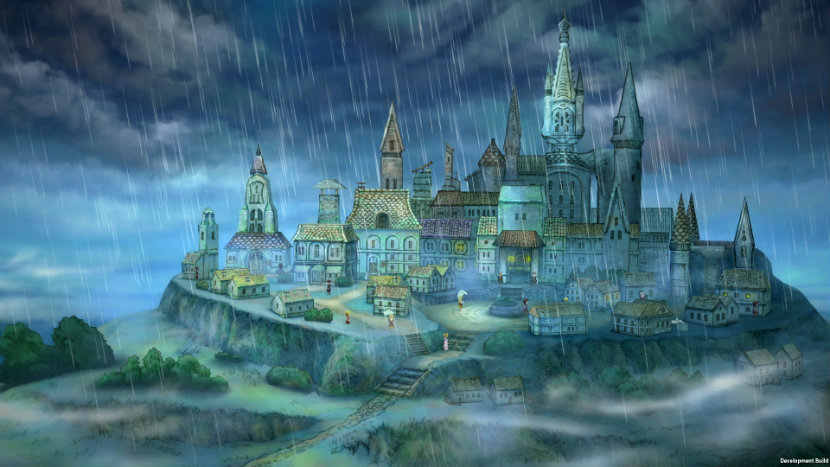
If you find yourself feeling curmudgeonly about today’s JRPGs, didn’t hate Final Fantasy II, and somehow never had a Nintendo 3DS, then boy howdy do I have the game for you. Originally published to little fanfare by Atlus USA, this joint development effort between Cattle Call, Grezzo, and FuRyu has come to the PS4 by way of HD remaster. Helmed by industry veterans with GOAT-status games under their belts, The Alliance Alive HD takes a cool idea (extremely old-school JRPG aimed at older players), fiddles with it a bit (makes it more accessible than the game before it), and makes it pretty (not on 3DS).
That Feel When You’re Even Too Nerdy for Nerds
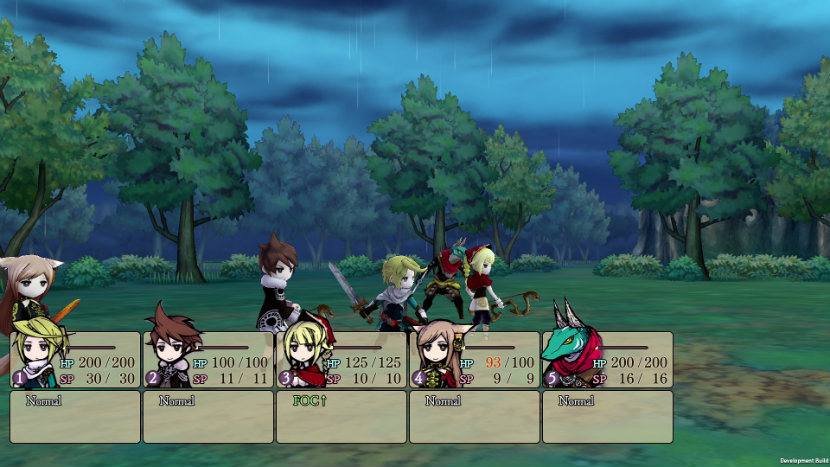
That previous game was The Legend of Legacy, another game from the same crew and fueled by the same goal. Director Masataka Matsuura and his homies wanted to make a game inspired by SaGa, so it’s a miracle The Legend of Legacy was ever localized. Granted, this generation also saw actual SaGa localizations too, with more on the way. Miracles do happen sometimes. Anyway, The Legend of Legacy had all the SaGa hallmarks: use-based stat boosts instead of EXP and levels, character choices governing the story, and also the team just straight up hired the guy who designed the combat systems in multiple SaGa games. So despite SaGa’s daddy Akitoshi Kawazu (who also directed Final Fantasy II, to clarify that earlier connection) nowhere to be seen, The Legend of Legacy may as well have been directly related.
It went about as well as you’d expect, with modest success in Japan and middling review scores over here in the west (I would have given it a higher score if I had reviewed it, for what that’s worth). This sequel of sorts, the actual subject of this review, comes from similar motivations but is also a reaction to feedback. Thus, we have The Alliance Alive. It looks and kinda smells like The Legend of Legacy, but it eschews a lot of the more intense SaGa-ness in favor of more relative simplicity. It still doesn’t go for basic exp grinding, but it doesn’t have all the stat-wrangling. In fact, it stops just short of doing away with stats entirely.
Throwing the Kids a Bone or Two
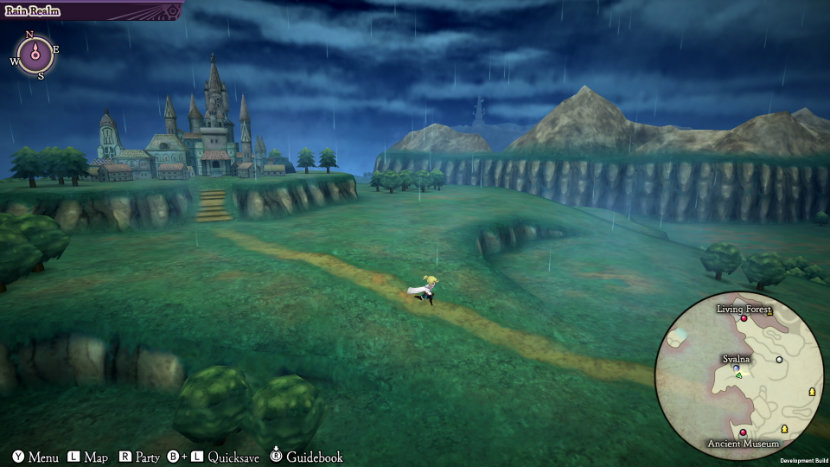
The Alliance Alive does retain elements from the team’s original inspiration. After combat, characters do randomly get HP or SP increases. There’re no exp or levels, as The Alliance Alive is mostly concerned about gear and abilities. Abilities are tied to weapon types, and you get more by using the ones you have. Using abilities can also make them get stronger. So, it’s sort of like SaGa, but a little lighter and friendlier. There’s also another layer of progression called Talent, which one can grind like exp.
Talents are passive bonuses, which do things like make SP costs lower, for example. Put enough time in, and you can even use some abilities for free! The costs are high though, so it’s a sort of “get what you give” situation. It almost feels optional, which is a bit weird. Overall, The Alliance Alive isn’t nearly as difficult as SaGa games can be, which is definitely the goal here.
Not only is The Alliance Alive easier than its predecessor (and inspiration), it’s also much more story-driven. SaGa games are usually fueled by their systems, and colored with themes and concepts more than plot. This game goes in the other direction, and is much more story and character-driven. Characters are introduced through story beats, although there is also a Suikoden-like element of optional (and sometimes hidden) character recruitment. Much of the cast is strange or charming in a quirky way, such as a girl who uses her scientific genius to make… a giant, shape-shifting duck mech. And yes, she fights in the duck.
Old School is Still Cool (for JRPGs anyway)
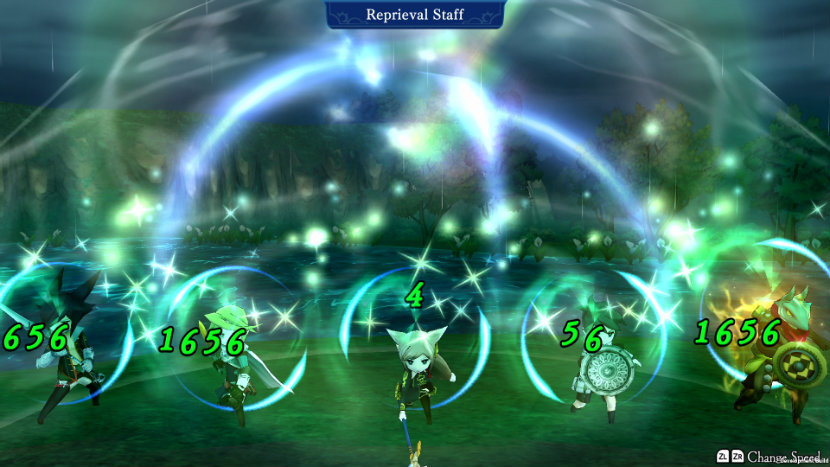
So The Alliance Alive is a breezy, accessible tribute to SaGa, that’s a spiritual follow-up to a more traditional and ornery tribute to Saga. Both games are worthwhile for their dedication to a unique niche, but if you never had a 3DS (this is PlayStation Lifestyle after all), this is a new chance to check this style out. As far as HD remasters go, this one is pretty simple. It’s the same game, with a higher resolution and a few visual changes to accommodate the drastic change. 3DS games are pretty ugly after all, so blowing it up to such a higher resolution would have exposed some… kinks. The character models are just sharper, but things like trees and bushes are totally different.
Personally, I prefer playing The Alliance Alive on a handheld. It isn’t the most visually complex game, so I feel like it thrives more on a smaller screen on a compact device. When I played The Alliance Alive HD on my TV, sure it looked a lot better, but it also felt off in a more experiential kind of way. The world map felt emptier, the animations jankier, the colors more muted. I hopped back over to the 3DS version for review purposes, and it felt much more appropriate. Plus, the UI living on the lower screen made for a much more elegant experience.
Obviously, I think The Alliance Alive is a great game regardless of what platform you play it on (that counts the Switch version as well). It has this weird “SaGa, but reined in some” vibe to it that could be a decent entry point into some weird JRPG shit. I would personally rather play it on a handheld platform, but The Alliance Alive HD does exactly what it’s here for on the PlayStation 4, and if that’s your console, this is a fine option.
It’s also totally great on a mobile PS4 remote play rig, which I messed around with as well. Regardless of how you play it, The Alliance Alive is a fulfilling JRPG that isn’t afraid to do things a little differently, while still showing its love for that classic 90s style. The Alliance Alive HD puts the game on modern platforms, and it’s absolutely a title deserving of a second chance.
The Alliance Alive HD review code provided by publisher. Version 1.00 reviewed on a Standard PS4. For more information on scoring please see our Review Policy.
The post The Alliance Alive HD Review – A Hint of SaGa, a Dash of Final Fantasy appeared first on PlayStation LifeStyle.
]]>The post Contra: Rogue Corps Review – Cybernetic Pandamonium appeared first on PlayStation LifeStyle.
]]>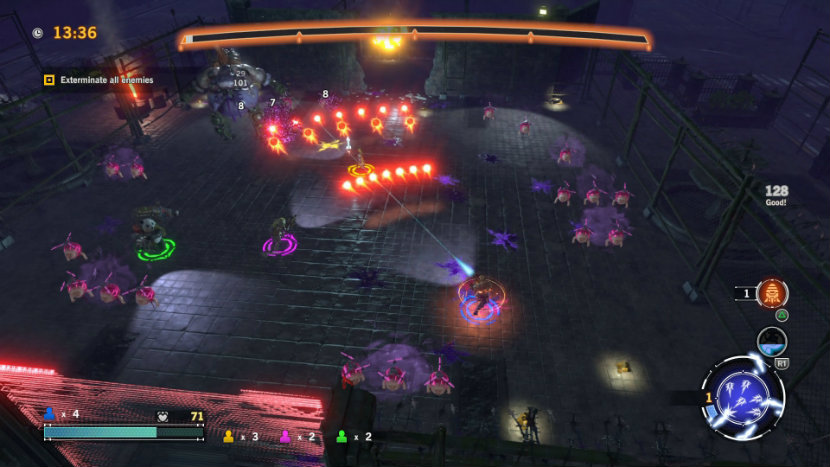
I, like many others, watched with befuddlement as a brand new Contra was revealed during a Nintendo Direct. Sure, Konami has been back on the radar with games like Super Bomberman R and its line of Anniversary Collection sets, but it’s still weird to see Contra of all things popping back up. With nearly a decade passing since the last game in the series, a lot has happened in gaming. So what does it mean to release a new Contra in 2019? The answer this time appears to be loot, multiplayer, and a healthy dose of post-ironic, crass humor. This is Contra: Rogue Corps, and I’m totally here for it.
What is a Contra? A Miserable Pile of Bullets
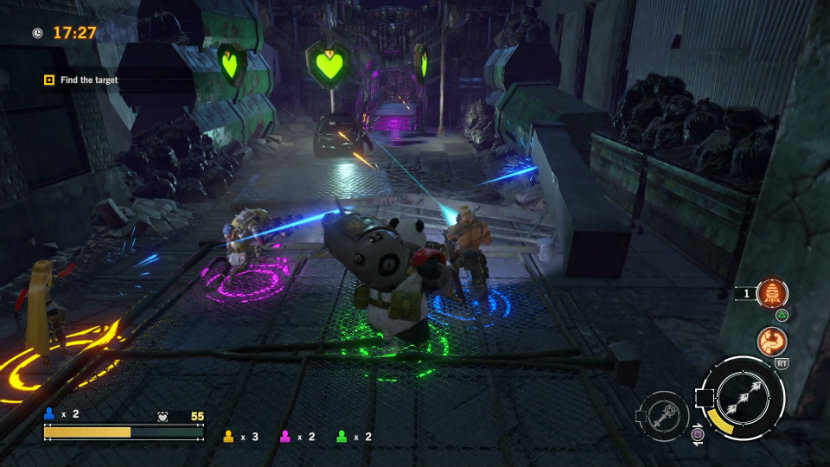
Contra has been through a lot over the years, but the core has always remained intact. Aliens are ravaging Earth, and it’s your job as either an 80s action film hero or 90s comic book cybersoldier to blow ‘em all away. It always starts with a machine gun, but thanks to special pickups, golden eagles providing lethal goodies from his holiness Uncle Sam, the running and gunning takes on different forms. The spread shot is the most famous of course, as it made the original game’s unrelenting difficulty much more manageable. Aside from this molten core, Contra has taken on other forms over the years.
That said, Contra has never exclusively been a sidescroller. Even the NES original experimented with perspective, having sections that looked more like the NES’ other “shooting gallery” games. Super C introduced top-down levels, and Contra III: The Alien Wars expanded on that thanks to the SNES’ fancy scrolling juice, and games since have dabbled further. While Contra is best known for scrolling and shooting, it has always been a space for light experimentation. So while it was jarring at first to see Contra: Rogue Corps, with its loud visuals and obvious twin-stick gameplay style appear out of seemingly nowhere, it makes plenty of sense that the developers (led once again by longtime series director Nobuya Nakazato) didn’t just take the same path WayForward did with Contra 4. There’s nothing traditional here in Contra: Rogue Corps, yet at the same time it still feels like it fits right in with its older siblings.
Somehow, the Contra series has an official timeline, which even includes Hard Corps. Granted, most of the games after Contra III are various forms of “bad shit happened after the Alien Wars,” and that’s exactly where Rogue Corps nebulously falls until further clarification. Sometime after the alien invasion is thwarted, a new threat literally rises from underground, corrupting the surrounding area and forming Damned City. Simply existing in this space makes the average person lose their mind due to all the bad alien/monster juju, but small groups with apparent immunity to those effects make a living out of scavenging the area for resources. You, your friends, and online randoms (or just you by yourself) control a squad of such vagrants, all of whom are heavily armed, gross-looking, and only marginally human. One of them is a panda with a human brain, and little panda drones. He’s my favorite.
Contra isn’t exactly a known vehicle for storytelling. After all the most renowned entries are basically about Rambo cosplayers shooting at H.R. Giger references. Rogue Corps takes the piss a little, dialing up the 90s corniness to a level past longing nostalgia and stopping just short of self-parody. It’s crass and vulgar, but it isn’t gross or creepy. Even the stoic narrator has a filthy mouth, but many of the worst tropes of the era just aren’t present. It isn’t full of pop culture references either; Rogue Corps is happy to just have fun being stupid, without trying too hard to be cool or edgy. It’s almost like a less self-indulgent Borderlands.
Bobbing for Brains
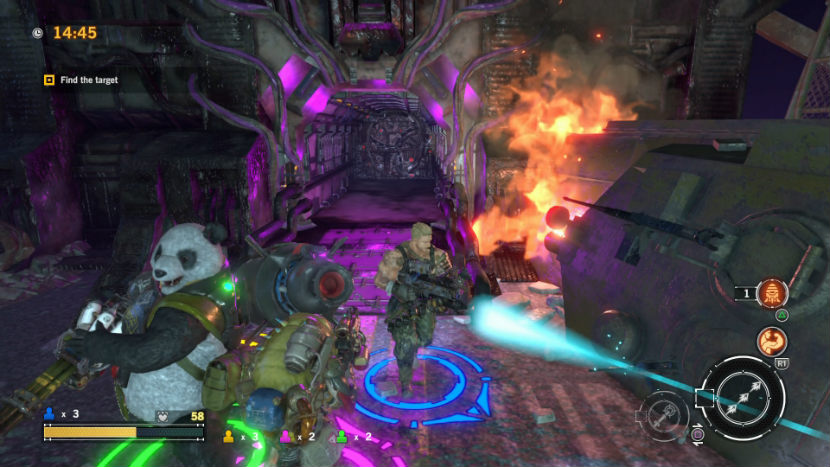
Speaking of Borderlands, Rogue Corps’ whole schtick (as Nakazato has stated in interviews) is taking elements and the general vibe of Contra, and modernizing it. The whole twin stick shooting thing isn’t really modern, but a lot of Rogue Corps’ infrastructure sure is. This is a score-chasing shooter with power ups and local co-op, but it’s also an online multiplayer game with loot-based progression. Just like in, well, any other game with bullets these days, you’ll be picking up color-coded drops from enemies and containers, and managing your loadout in-between stages. The weapon stuff is pretty straightforward, with each character having their starting weapons (although you can swap them around which is neat) and upgrades comprising feeding crap parts to boost stats, and equipping good parts as your capacity increases. The other set of equips is much less straightforward, but much more fun.
Rogue Corps’ goofier take on Contra‘s usual post-apocalyptic cyber warfare is best represented with its bizarre characters, but in second place comes the body parts loadout. Remember when I mentioned the panda? He’s the result of cybernetic experimentation gone wrong, but that doesn’t stop the scavengers from taking on comically dangerous transplant operations in the name of righteous destruction. Instead of the usual pouches and body armor, you’ll be upgrading your brain, eyeballs, heart, so on and so forth. And mucking around with your organs in a mind-altering wasteland isn’t a smooth process. You can just transplant your new parts for free from the one sketchy surgeon, sure; but if you toss some coin at the more deranged medical professionals in the surgery shack, you might get more bonuses. Or… well, the surgery won’t go as planned and something completely different will happen. Ultimately it’s just more stat and passive boost tinkering here, but the craven diegetic set-dressing rules. Especially since you can sit and listen to all the horrible squelching sounds of your own body being desecrated by mad science.
As much as I like the setup and narrative justification for all the uh, shlooting, there is one major issue. This game is all about fast and frantic action, as it should be. However, upgrading your equipment bogs things down quite a bit. I’m a Diablo guy, so I don’t mind screwing around in menus every now and then. But the grind here is a bit unbalanced. See, in addition to messing with parts, your weapons also net experience points from finishing levels. You need those levels to upgrade weapons to the next grade, which boosts stats, but more importantly increases the limit for more parts. It feels like it takes way too much time to get the ball rolling there, especially to get to the first opportunity to upgrade. I was stuck with one part on my panda’s starting machine gun for several levels before I could get to two parts–and there are plenty more slots to unlock. That’s a lot of dedication Rogue Corps wants in order to get real stronk.
I Forgot to Try the Konami Code
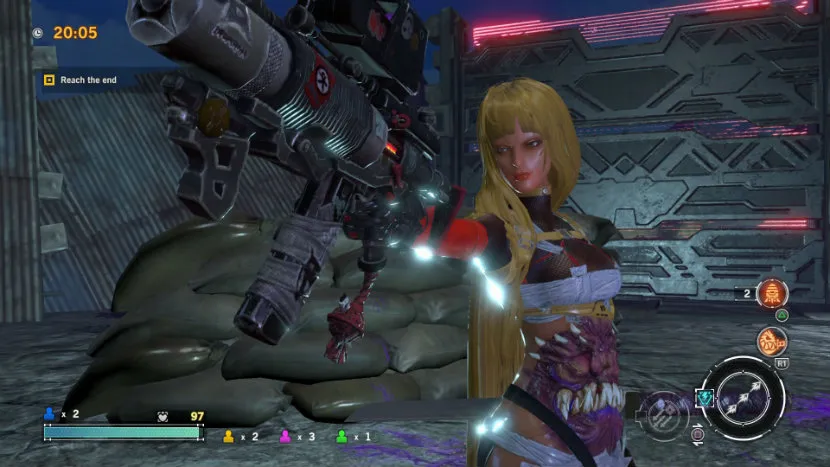
Luckily, actually playing Rogue Corps is a real blast, especially with a crew. I got to play some co-op, both local and online, and it was a blast. There are a couple different ways Rogue Corps quietly pushes you to play with other people, and the payoff there feels good. For example, there’s a set of special collectibles in each level, but they only appear for a limited time before vanishing. Even if you only have one other player, it’s easy to coordinate one person chasing the goodies, and the other maintaining the enemies long enough for the first person to snag the prize and get back to work. Splitting enemy attention also helps navigate the game’s tight spaces, and seeing everyone’s different weapons and abilities pop off is just exciting. There’s also a versus mode, which actually has some interesting modes considering how bad “versus twin-stick shooter” sounds on paper. It’s not something I’ll really go back to, but the cooperative play is where the spirit of Contra truly lives.
Speaking of Contra’s spirit, Rogue Corps is full of it. While most of the game avoids nostalgia pandering, there are definitely nods to the series in fun ways. The music occasionally dives into rearrangements of familiar tunes, the golden eagle with the bright red “S” makes multiple appearances, and the original game’s ridiculous, spinny jump animation is even sillier in 3D. Special weapon power ups are more like say, Metal Slug (limited ammo), but boy howdy does that spread gun still rule. Sometimes the twin-stick action changes to “shooting gallery” mode, which are brief setpieces that nod towards the perspective swapping of old. Again this isn’t about recreating the old school Contra style, but the DNA and love language for the series is still all over Rogue Corps.
Despite my initial hesitation, I found myself really digging Contra: Rogue Corps. My fears that it looked like a cheap, grody-looking, nothing game trying to cruise on a classic IP ended up being completely unfounded. Instead, what I got was a game clearly under Kawazato’s supervision, but with younger blood coursing through its veins. Rogue Corps understands the appeal of revisiting gratuitous 90s cheese, but filters out all the tropes we’ve grown out of since. By injecting actual, creative humor instead of edgy cynicism or boring references, Contra: Rogue Corps really has a personality of its own despite most of the storytelling living in the background. And while some of the progression can feel like a grind, the loot systems get cute and tie into the theme, which is more than I can say for most other boilerplate loot systems. Add smooth and productive multiplayer modes to the mix, and you have a game that can easily soak up a game night or two. I know all the Konami drama was rough for a while there folks, but this is good stuff.
Contra: Rogue Corps review code provided by publisher. Version 1.00 reviewed on a Standard PS4. For more information on scoring please see our Review Policy .
The post Contra: Rogue Corps Review – Cybernetic Pandamonium appeared first on PlayStation LifeStyle.
]]>The post Ni no Kuni: Wrath of the White Witch Remastered – Rose-Tinted Magic (PS4) appeared first on PlayStation LifeStyle.
]]>
Alright folks, buckle up; if you’re one of the many JRPG enthusiasts who loved Ni no Kuni back on the PS3, this review won’t be for you. This release is just Ni no Kuni but better-looking, and if that sounds great to you, then you’re in for a good time. Ni no Kuni: Wrath of the White Witch Remastered is a straight-up enhanced port of the PS3 original, running at a smooth 60 frames per second at 1080p on a standard PS4. It doesn’t quite reach 4K/60 on a PS4 Pro, but it can do 4K/30 with a 1440p option for the faster frame rate. Otherwise it’s the same game, with no extra bonuses or amenities. Normally that sort of a release might be difficult to assign a score to, depending on what a critic might expect from the average re-release (especially since the Switch version apparently needs some work). Luckily, yours truly hasn’t actually played Ni no Kuni substantially before, so your boy jumped in here with a fresh set of eyes. I can see why the PS3 version had the impact it did, but as a common resident of this specific genre space, I was surprised to find myself a little underwhelmed.
Movie Magic
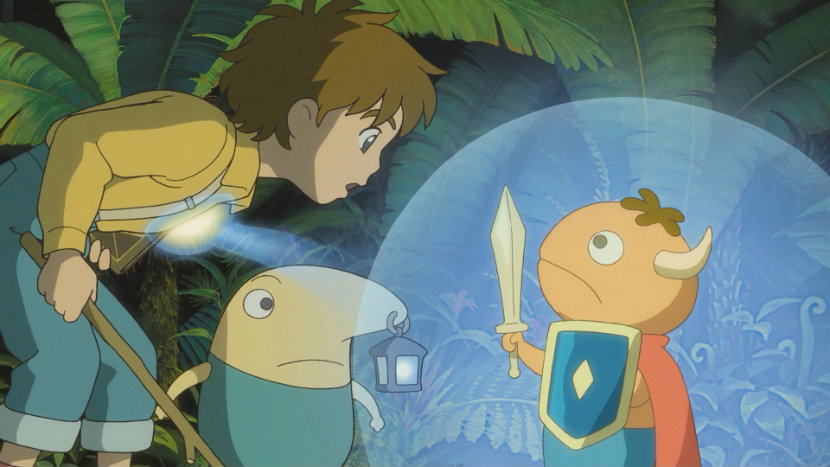
Studio Ghibli has a special kind of power as a studio. It is, frankly, the only anime studio that has a cultural hold on the scale it does, with many folks over here in the west knowing what “Studio Ghibli” means even if they aren’t anime fans otherwise. Hayao Miyazaki and his teams and understudies cranked out masterpiece after masterpiece, developing a house style built on an unmatchable foundation. Even when there’s an occasional miss, the craft and artistry in the average Ghibli movie (in animation alone) stands out among peers. So when Level-5, a developer that had been building a reputation thanks to projects like Dragon Quest VIII, announced a collaboration with an anime studio so powerful Disney was shelling out big bucks for Hollywood voice actors, people over here noticed.
The buzz for Ni no Kuni was ridiculous, especially during a time when JRPGs were losing their luster with larger audiences, and localizations were relatively sparse. But after all the noise and hype, Bandai Namco came through with a western release, and slight controversy over special editions aside, fans and critics alike ate it up. From animated cutscenes produced by Studio Ghibli, to a Joe Hisaishi soundtrack and a story that targeted feelings of childhood nostalgia, Ni no Kuni: Wrath of the White Witch hit all the right notes to stand out. So much so that we recently saw a sequel, which was almost just as well-received. But the sequel, aside from losing the Ghibli backing, had another major difference from its older sibling. The combat gameplay moved from a Pokemon-like, pseudo real-time, menu-based system to a more straightforward action/RPG. And there’s a reason for that, in my estimation.
Ni no Kuni’s battle system, the part of the game you’ll spend the most time in, seems confused about what it wants to be. This game came out in the late 2000s, at a time when developers, critics, and even some players had convinced themselves traditions like turn-based combat weren’t any good. This was proven wrong later, but not before Ni no Kuni itself was caught in the crossfire. This game, which is full of color, whimsy, and heart, displays a severe lack of confidence under the hood. To support my argument here, I need look no further than… Ni no Kuni. No, not the sequel, the other one. The one you can’t pick up at a GameStop.
Thank Goodness We Got Over This
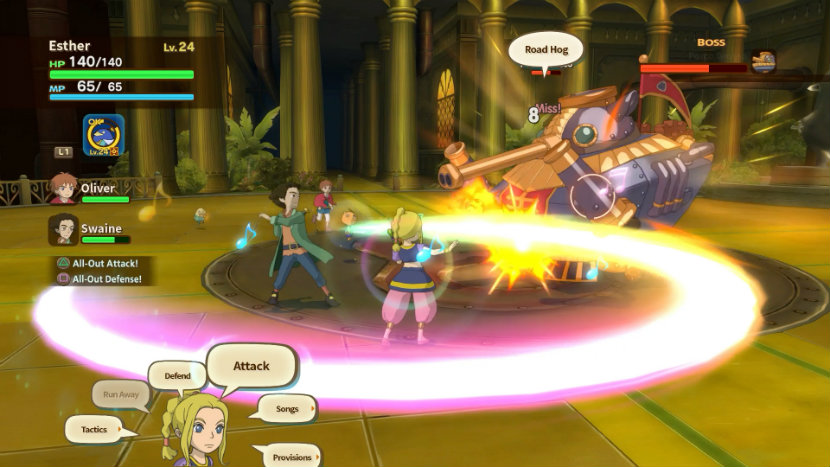
The original Ni no Kuni is actually two games. Before it hit PS3, Level-5 released a Nintendo DS game titled, Ni no Kuni: Dominion of the Dark Djinn (rough translation, there isn’t an official localization). The DS version and PS3 version were in development around the same time, but the focus was on getting the DS version out first because that was the dominant platform. And if you take a look at the DS version (which was fan translated late last year), you can see a lot of DNA that moved on to later Level-5 projects, particularly Yokai Watch. While the console Ni no Kuni shares similar story beats and even music in some cases, the core gameplay is entirely different.
Aside from a gimmick involving a physical spellbook players needed to refer to, Ni no Kuni on DS was a Dragon Quest-inspired, turn-based JRPG. It still had the monster collecting, but battles played out in a straightforward manner with choosing commands and having the time to think about them. Sure, it isn’t as “unique,” but it makes plenty of sense, especially in that monster-collecting space. That genre benefits a lot from more methodical, tactical play. On the other hand, the PS3 (and subsequently PS4) Ni no Kuni takes some of the ideas from the DS game, but shifts them around into something more active. But it isn’t entirely active, as there are key limitations in place. In fact, based on some weird choices, there are actually less options in the moment to moment play despite Ni no Kuni’s console iteration looking and feeling more complex.
In the DS version, while you can only have one monster (or Familiar in game terms) out at a time, but both Oliver and Drippy (the dude with the serious nose piercing) also participate in battle. In the console version, Drippy hangs out on the sidelines, and you can only control either Oliver or one of the familiars. But regardless of your active character, everyone shares the same HP/MP pool. This means you’ll either need to be careful with how you use your resources, or keep hella stocked on restorative items. On one hand, encouraging less conservative play (especially with MP items) is a neat touch, but at the same time managing your characters and skills is fumbly, especially since the Familiars have a time limit. It charges back up once they go on the bench, but you’re still forced to swap between characters, regardless of the battle context.
The part I really didn’t like is how navigating Ni no Kuni’s physical combat space works. You can move freely within the “arena,” which is more or less a big circle. You choose your menu commands in real time (think Kingdom Hearts, sort of), and swapping characters pauses the action. Every action has a cooldown, and basic attacks go for a little while as a timer ticks down (even if your character is positioning and not actively swinging). Sometimes, there are situations in which you can maneuver around an enemy to attack a weak point, or in a parallel situation, you might need to move around to avoid a shield or some other armor. Meanwhile, enemies attack you in turn, and sometimes have tells for their big moves (which you can dodge or block by various means).
It all feels fine and responsive, and looks pretty cool in motion especially with the beefed-up frame rate. However, there isn’t a clear, tangible sense of the space you occupy versus the space an enemy occupies, and how those two concepts intersect. You can move around, but it seems like enemies can hit you regardless (like a MMO), or perhaps moving further away makes them miss – that seems to be the case at times but the game never offers an explanation. Areas of effect aren’t really a factor, until sometimes they suddenly are, and you also get to fight your characters’ instincts to attack enemies head-on when you need to run and find a weak point. It’s painfully obvious to me that Ni no Kuni was designed first as a turn-based game, then molded and hammered into something else to justify itself to a confused idea of what the console JRPG-playing audience was at the time. The DS version’s gameplay makes more sense with what’s happening in that game, and the more honest real-time shtick in Ni no Kuni II makes more sense as well. I’m not suggesting trying new things is a problem (Final Fantasy VII Remake seems to be nailing it), but this set of new things feels misguided.
You Can Catch ‘Em All, I Guess. If You Want To
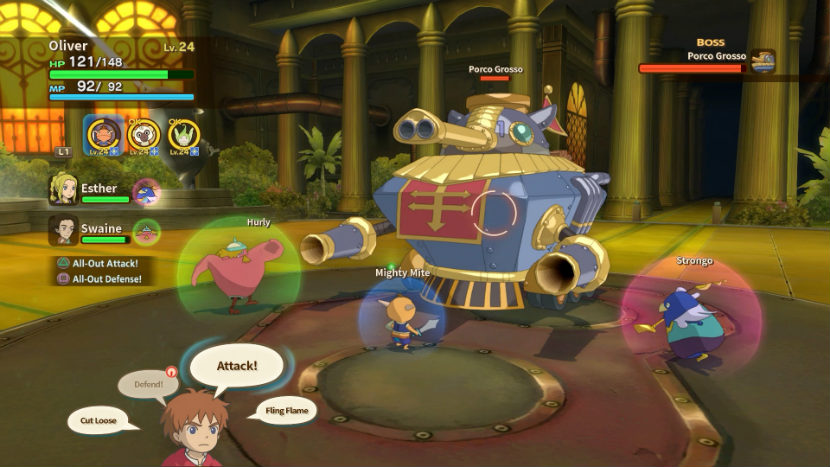
Speaking of what’s happening, Ni no Kuni also fumbles the ball a bit with its monster collecting. There’s a lot of stuff you can mess around with to build your stable, but a lot of the ideas don’t really land in a way that feels cohesive. It’s also hard to want to do anything but build physical attackers since using spells in combat doesn’t feel good. There are evolutionary chains for familiars, but the items required just drop from battles and evolving just happens from tinkering in menus. There are stat-boosting items, but you can just buy them in shops for cheap and there are ill-defined limitations to them that feel like boosting units in a gacha game. There’s a Pokemon-like move pool, but it’s also weirdly limited and once again, clashes with the combat systems. Once again I see why this was abandoned for the sequel, and those energies were spent elsewhere (shout out again to Yokai Watch).
I had fun with Ni no Kuni: Wrath of the White Witch Remastered, but I found myself knocking it down to easy so I could just hit things without thinking too hard, and going through the more compelling sights and sounds without having to dive into a bunch of clumsy systems I didn’t enjoy engaging with. The Ni no Kuni world is so much fun, and the Ghibli-produced cutscenes are not quite up to par with the studio’s theatrical work, but not too far off. I love the sequel, and the DS game is something I’m definitely looking forward to checking out. But as far as this game is concerned, it feels more like Level-5 figuring out what it wanted to be in the modern era. While it’s clumsy and frustrating compared to its peers, it’s still such an ambitious and wholesome project it’s hard not to be into it regardless.
Ni no Kuni: Wrath of the White Witch Remastered review code provided by publisher. Version 1.00 reviewed on a Standard PS4. For more information on scoring please see our Review Policy.
The post Ni no Kuni: Wrath of the White Witch Remastered – Rose-Tinted Magic (PS4) appeared first on PlayStation LifeStyle.
]]>